l

Table of Contents
Chapter I: Overview
Chapter II: Character Options
Class Archetypes
Races
New Equipment and Features
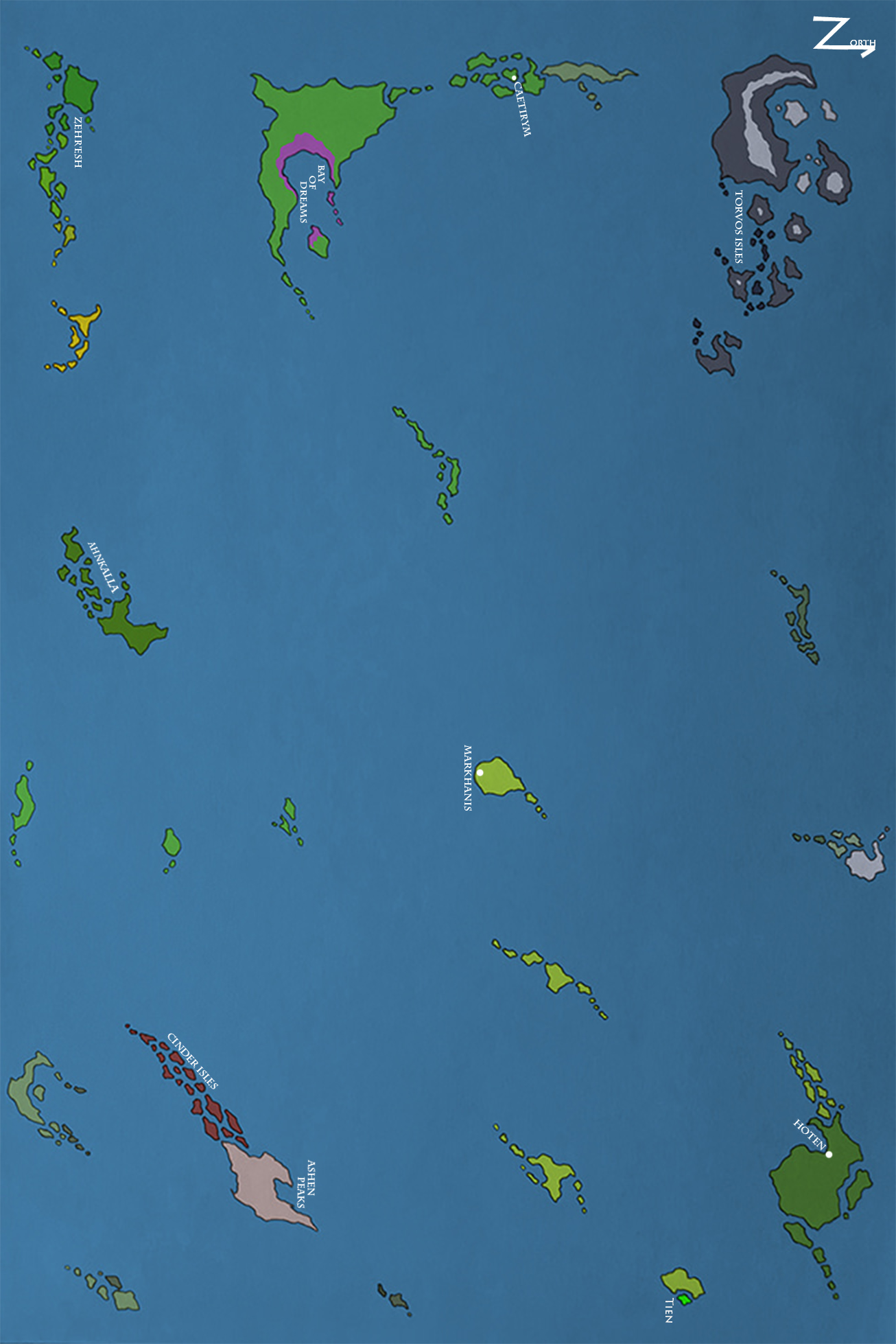
Chapter 1
Background
The History of Valindris
The world of Valindris is now covered by vast oceans and waterways. This wasn't always the case though. In ages long past, Valindris was a beautiful world filled with a large variety of landscapes. However, roughly 1,200 years ago the oceans rose up and swallowed the land. Empires were drowned and glorious cityscapes reduced to ruble by the onslaught of tidal waves.
Not much is known for sure about how it happened, but there is a myth. A story that is so widely believed and shared, that there must be some truth buried within it.
The Great Calamity
Many believe that the world was drowned by the actions of a being known only as the Drowned One. It is said that the Drowned One ruled over some portion of the elemental plane of water. The story goes that the Drowned One grew bored with its dominion over the plane of water and grew greedy as it saw what the gods had created within the prime material plane.
So the Drowned One schemed. It plotted and thought up a plan that would see it through to the prime material plane. Eventually, it breached through to the material plane at a point where the barrier between the planes was weak. Initially, the water that poured through the tear didn't cause much damage. Though its plan wasn't over yet.
After arriving on the material plane, the Drowned One brought through a massive army of sea creatures from its home plane. Over the next century, the Drowned One sat quietly building its power in the darkest reaches of the ocean. Eventually, it brought its army to the surface. It is unclear how, but the Drowned One also managed to tear a rift between the material and elemental plane of water wide open.
War was waged, and it was a savage war. With ocean levels rising at alarming rates, most of the armies of the surface stood little chance against the Drowned One's onslaught. Eventually, the Gods themselves gave divine blessings to mortal champions in order to stand up to the Drowned One. The war continued on for years before finally, a champion of Selune struck a mortal blow against the Drowned One itself.
This champion of Selune is now commonly known as Ren, the Restorer of Balance. It is said that though the wound Ren dealt was grave, it did not kill the Drowned One, but instead left it wounded enough that it could be bound and imprisoned by some divine ritual. It is unclear why the Drowned One wasn't killed, but many believe that it is perhaps because it cannot truly die.
The World After the Flood
After the world flooded, societies were brought to ruin. It took centuries to recover some semblance of order in most of the world. Though the mortal races were helped along by what is referred to today as The Great Reordering.
Some time after the war had ended, the gods looked upon Valindris and took pity on the people of it. A group of dieties took it upon themselves to restore some bit of what the world was before the Drowned One's assault. The rift to the elemental plane of water was sealed and a great deal of land was risen to the surface of the now much wider oceans.
It is believed that Lathander lead this charge along with Helm, Torm, and Tyr. These gods ended up using all of their divine power to reshape parts of the world. Because of this each ended up giving their very essence into the land, ultimately falling from divinity. Their sacrifice is regarded by most people of the world as the greatest and most noble sacrifice that could have been given. The supposed day of this event is celebrated each year for one week with large festivals, feasts, and parades. It is known as Remembrance.
Valindri Calender
The Valindri year consists of 11 months. Weeks contain 5 days, each named after a constellation: Vesra, Caelia, Vespira, Eastwald, and Elianne. Months are named after important figures from Valindrin history.
| Month | Days | Events and Holidays |
|---|---|---|
| Dawn | 34 | Lunar Rebirth (1st) |
| Cassiel | 30 | Artisan's Cry (7th) |
| Iria | 26 | Heaven's Flare (18th) |
| Ambriel | 40 | Ambriel's Awakening (1st) |
| Leonis | 33 | Tides Mercy (21st) |
| Aquos | 29 | Sea's Bounty (9th & 10th) |
| Renthas | 31 | Star's Tilt (12th) |
| Tyras | 40 | Ambriel's Slumber (40th) |
| Helmas | 29 | Resplendent Harvest (13th & 14th) |
| Tormas | 30 | Champion's Day (16th) |
| Lathandras | 32 | Remembrance (27th - 32nd) |
Holidays
The Valindri people are mostly proud folk. They enjoy celebrations in most places, and choose to honor the past where they can. There are many other holidays celebrated by the different cultures and nations of the world, but the main holidays in Valindris are:
- Lunar Rebirth celebrates the lunar new year. It is typically celebrated with family and used to wind down from the Remembrance festivals the week before.
- Artisan's Cry is a celebration of crafters and artists. It is generally celebrated with plays, games, and large marketplace displays.
- Heaven's Flare marks the passing of a wild and colorful meteor storm across Valindris' skies. It is believed by many to bring good luck and fortune.
- Ambriel's Awakening marks the day that Valindris' second moon, Ambriel appears in the sky. It is located far beyond the world's primary moon and only comes into view for a few months a year.
- Tides Mercy is a day used to pray for safe tides and the quelling of storms.
- Sea's Bounty is a summer feast made up of the best seafood that can be found.
- Star's Tilt celebrates a shifting in the constellations in the sky. Most believe it is caused by the Gods competing in games.
- Ambriel's Slumber marks Ambriel's disappearance.
- Pespendent Harvest is a large feast celebrating the closing of the harvest season.
- Remembrance is a week long celebration in honor of the God's who sacrificed themselves to remake what they could of the world.
The Gods & Religion
There are many gods that watch over Valindris. Some have the strong following of a kingdom or nation, while others work off the prayers and worship of small tribes or bands of pirates. Here are a list of some of the more prominent Gods in the world of Valindris along with what domains they watch over and where their worshipers can mostly be found.
Pelor, god of the sun and healing
Alignment: Neutral Good Domains: Light, Life
Selune, goddess of the moon
Alignment: Chaotic Good Domains: Knowledge, Life, Lunar
Sashelas, goddess of the sea
Alignment: Chaotic Good Domains: Nature, Tempest
Iria, goddess of cunning and revelry
Alignment: Chaotic Neutral Domains: Trickery
Kord, god of athletics and war
Alignment: Chaotic Good Domains: Forge, Tempest, War
Melora, goddess of the harvest, wilderness, and nature
Alignment: Neutral Good Domains: Lunar, Nature
Ren, the restorer of balance
Alignment: Lawful Good Domains: Light, Lunar, War
The Raven Queen, goddess of death and the afterlife
Alignment: Neutral Domains: Grave, Knowledge
Ishta, goddess of innovation and change
Alignment: Lawful Good Domains: Forge, Knowledge, Light
The Drowned One
Alignment: Neutral Evil Domains: Death, Knowledge, War
Organizations & Factions
In this section you will find a list of some of the factions from across Valindris along with some information about that groups goals, location, and leader or leaders.
The Freehold Brotherhood
Location: Ahnkalla Leader: Dread Captain Aldrice
The freehold brotherhood are a large unsavory group of pirates, thieves, and sellswords. Those criminals that have taken up arms under the Freehold banner are a brazen bunch. Striking openly against merchant ships, stealing technological shipments from Markhanis, and ransacking port towns. They are wanted at large by many governments of the world.
The brotherhood has settled into Unlai Bay on the remote jungle covered island of Ahnkalla. From there, they plot and scheme. Their leader, Dread Captain Aldrice is rumored to be an immortal warrior with no match. Many head hunters and adventurers have attempted to collect the bounty on his head. None have returned.
The Skaldir Clan
Location: Torvos Isles Leader: Valisha Freya
In the northern seas on the Torvos Isles resides the Skaldir Clan. A ruthless clan of warriors and shamans comprised largely of Goliaths and Humans. From a very young age, the Skaldir are taught to fight. When a child reaches the age of 12, they are taken out into the sea and left on a small raft with nothing but an oar and a spear. The child is expected to return home with a worthy trophy. Surprisingly, many of the Skaldir children return, often with loot from a small merchant ship or the head of some great monster of the deep.
The Skaldir are completely and totally fearless. They are feared in the northern sea due to their war bands that patrol the coastal waters of the north. The Skaldir have a reputation for sacking ships twice as large as theirs and killing or capturing 3 people for every 1 of theirs.
The Verdant Sentinels
Location: N/A Leader: Grand Warden Kira
The Verdant Sentinels are a group of highly trained warriors who serve the goddess Melora. The sentinels exist to combat threats to nature no matter where they come from. Sentinels are often found patrolling the wilds of the world in small groups. They are feared by those who know of their wrath, and are often the undoing of any with reason to fear them.
The Flamewardens
Location: Cinder Isles Leader: Flamekeeper Dalvo
The Flamewardens are an ancient order of warriors who safeguard Valindris from treats from the elemental plane of fire. The order is generally secretive and cryptic, though recently they have reached out for help in the Cinder Isles, where it is believed a great Firelord from the fire plane is planning an invasion of Valindris. The flamewarders do not take threats like this lightly, nor do they allow rumors to fester without proper investigation. If they are reaching out for help, it usually means the threat is real.
The Jade Monastery
Location: The Jade Forest Leader: Mistcaller Li
The monks of the Jade Monastery lead a secluded life within the Jade Forest. These monks have taken up the calling to safeguard the world against threats from the elemental plane of air. Over the centuries of their existence, they have also developed their own unique and tranquil form of martial arts called Mistweaving.
The Jade Monastery is also known throughout Valindris for its exceptional tea and ale.
The Markhesian Guilds
Location: Markhanis Leader: Various
Within the great city of Markhanis there are a number of different guilds that each put forth a member to serve in the city's senate. Most guilds represent some type of craft or profession and they wield unimaginable power within the city. It is also widely believed that even the poorest of these guilds has enough gold stockpiled to fund its own kingdom. It is because of this that they are believed to be the endgame that the Freehold Brotherhood have planned.
The guilds often employ strong adventuring types to perform odd jobs and tasks. Paying handsomely for what are sometimes deadly jobs.



Ash Walkers
Location: The Ashen Peaks Leader: Gehrman
The Ash Walkers are a fearless band of hunters that reside in the Ashen Peaks. They were formed shortly after the advent of black powder. With a supply from Markhanis, the Ash Walkers combat the terrifying threats that roam the peaks. They have adopted unconventional methods for stalking prey that is larger than life. Including biological stimulants that enhance their strength, breathing devices that allow them to walk the peaks freely, and possibly the one of the most shocking displays of firepower: the Ballistola, a versatile and highly portable siege weapon.
The Council of the Furnace
Location: The Ashen Peaks Leader: Slaglord Ignis
Atop the Ashen Peaks sits the Eternal Furnace, the ancient kingdom of the fire giants. Their empire's numbers have dwindled since the flooding of the world, but they still remain on top of the Ashen Peaks. The millennia of smoldering conditions at the mountaintop has left the surrounding isles covered in ash and cinders. The fire giants of the Eternal Furnace tend to not care for the mortal races however, and fiercely meet any attempts at diplomacy with molten fury.
The Vendillion Clique
Location: Bay of Dreams Leader: N/A
Within the vibrant and wild Bay of Dreams is the Vendillion Clique. A group of pixies from the Feywild that were exiled from their respective courts long ago. After their exile, they took up residence in what is now known as the Bay of Dreams. They are a mischievous, chaotic council of fey that seek out their own amusement over most other things.
The clique has been known to grant visitors favors and boons in exchange for odd requests.
The Coilfang Naga
Location: Southern Isles Leader: Lady Vashj
The Coilfang naga are a force left by the Drowned One's invasion of Valindris. They have stayed hidden away in the depths of the oceans for centuries but have recently started to surface in the southern regions of the world. They are lead by a figure known as Lady Vashj, who was a general of the Drowned One during the war. What the Coilfang seek is unknown, but it cannot bode well for whats left of the surface world.
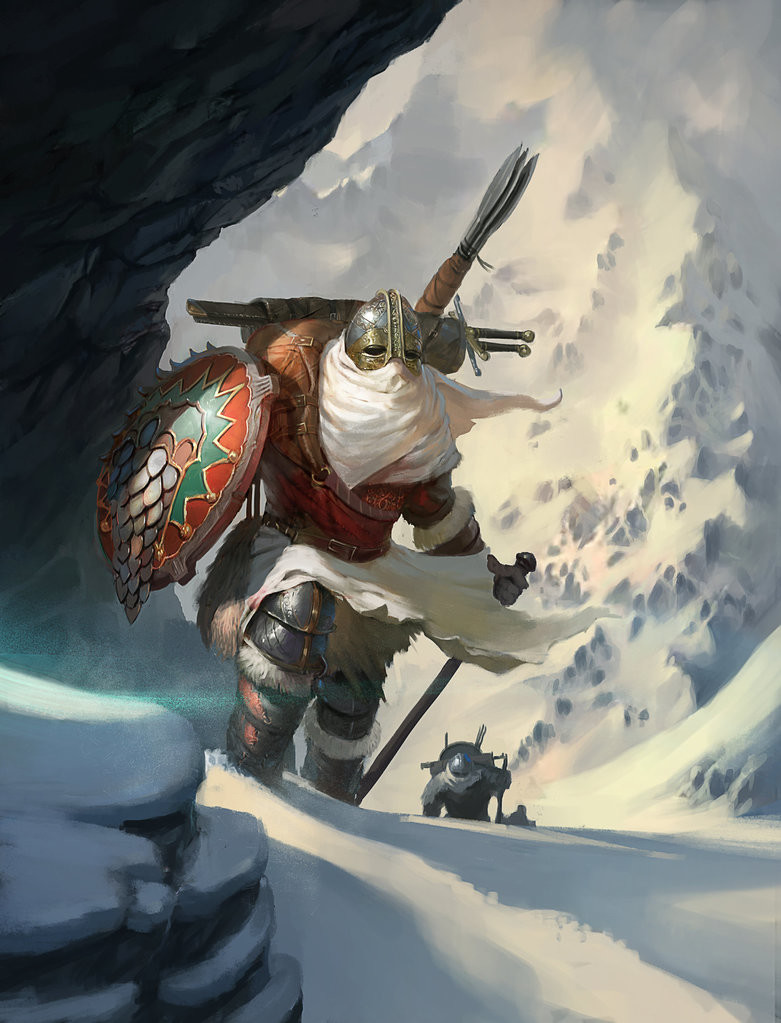
Chapter II
Character Options
Character Options
Path of the Reaver
The Skaldir are fierce warriors. Their raiding parties are feared throughout the northern waters of Valindris and no aspect of their fighting force is feared more than the Iron Reavers; A frenzied rush of steel and blood.
Barbarians that adopt this path become the embodiment of the Skaldir combat mentality. They prefer fighting in the close quarters of ships and cleaving multiple foes in a whirl of blood.
Path of the Reaver Features
| Barbarian Level | Feature |
|---|---|
| 3rd | Seaborne, Into the Fray |
| 6th | Furious Charge |
| 10th | Frenzied Cleave |
| 14th | Crazed Bloodlust |
Seaborne
Starting when you choose this path at 3rd level, you become very familiar with the open water and life at sea. You gain a climb and swim speed equal to half of your movement speed. At 10th level, this increases to become equal to your movement speed.
Into the Fray
Beginning at 3rd level, you become more
comfortable in battle when outnumbered. While you
are raging, you gain a +1 bonus to attack rolls for each enemy creature after the first within 5 feet of you.
For example: If there are 4 enemy creatures within 5 feet of you, you gain a +3 bonus to attack rolls.
Furious Charge
Starting at 6th level, you have mastered the charge to battle and know how to lead others behind you. When you roll initiative, you can forgo the advantage granted by the Feral Instinct feature in order to mark a creature for first blood.
Attacks against a marked creature in the first round of combat deal additional damage equal to half of your Rage Damage.
Frenzied Cleave
At 10th level, you become the master at striking down multiple foes at once. Once per turn while you are raging, you can cause an attack to hit all creatures within 5 feet of you.
You may use this feature a number of times equal to your Strength modifier (minimum of one). You regain all
expended uses when you finish a long rest.
Crazed Bloodlust
Beginning at 14th level, you have honed
your ability to strike down foes. When you
reduce a creature to 0 hit points with an
attack, you may immediately make one free attack against a different creature within your reach. This effect continues as long as you reduce a creature to 0 hit points with an attack.
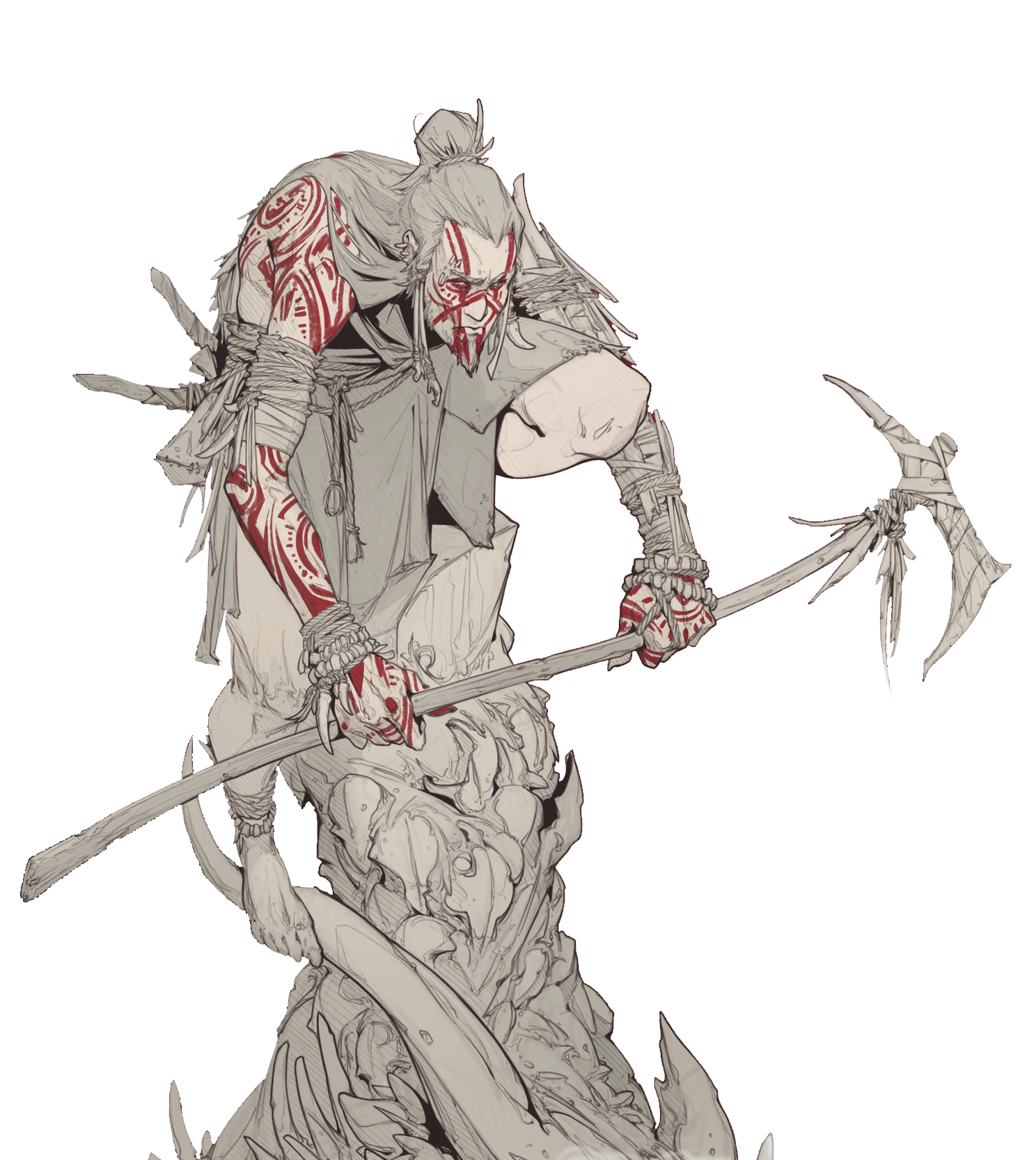
The College of Journeys
The College of Journeys is for the bard that mastered their craft while sailing on a mighty pirate vessel, on the back of a caravan transporting rare materials to Markhanis, or even one who's spent their time wandering the isles of Valindris with trusted friends. These bards are always amazed by new sites, and eager to spin songs and tales of epic adventure and daring escapes.
College of Journeys Features
| Bard Level | Feature |
|---|---|
| 3rd | Bonus Proficiencies, Traveler's Boon, Wanderer's Magic |
| 6th | Expedience |
| 14th | Wondrous Tale |
Bonus Proficiencies
At 3rd level, you gain a grand understanding of travel and how to help others along the way. You gain proficiency with the Survival skill.
Additionally, you gain proficiency with Navigator's and Cartographer's tools.
Traveler's Boon
Beginning at 3rd level, you learn how to ease movement for yourself and your traveling group. Your speed increases by 10 feet.
Additionally, when you grant a creature Bardic Inspiration, they can use their reaction to move up to half their speed.
Wanderer's Magic
Starting at 3rd level, you learn an additional spell when you reach certain levels in this class, as shown in the Wanderer's Magic table. The spell counts as a bard spell for you, but it doesn't count against the number of bard spells you know.
Wanderer's Magic
| Bard Level | Spell |
|---|---|
| 3rd | pass without a trace |
| 5th | leomund's tiny hut |
| 7th | find greater steed |
| 9th | commune with nature |
Expedience
Beginning at 6th level, you are able to boost your companions morale and make travel not only more enjoyable, but faster. While traveling overland, you can expend one use of your Bardic Inspiration to quicken the trip. When you do this, the time required to reach your destination decreases by 25%. You can use this feature once per destination you are traveling to.
Wondrous Tale
At 14th level, you are able to spin exciting tales of adventure. As a bonus action, you expend one use of your Bardic Inspiration to begin recounting a the tale of some legendary adventure. When you do so, choose any creatures from among those who can hear you. These creatures each gain a pool of 3d8. These dice can be used as though they were given by your Bardic Inspiration feature, but can be used along with your Bardic Inspiration dice if a creature has both.
Maintaining this effect requires your concentration as if you were concentrating on a spell. If your concentration is broken, all creatures who gained a dice pool from this feature lose them.
A creature can only benefit from this effect once per day.
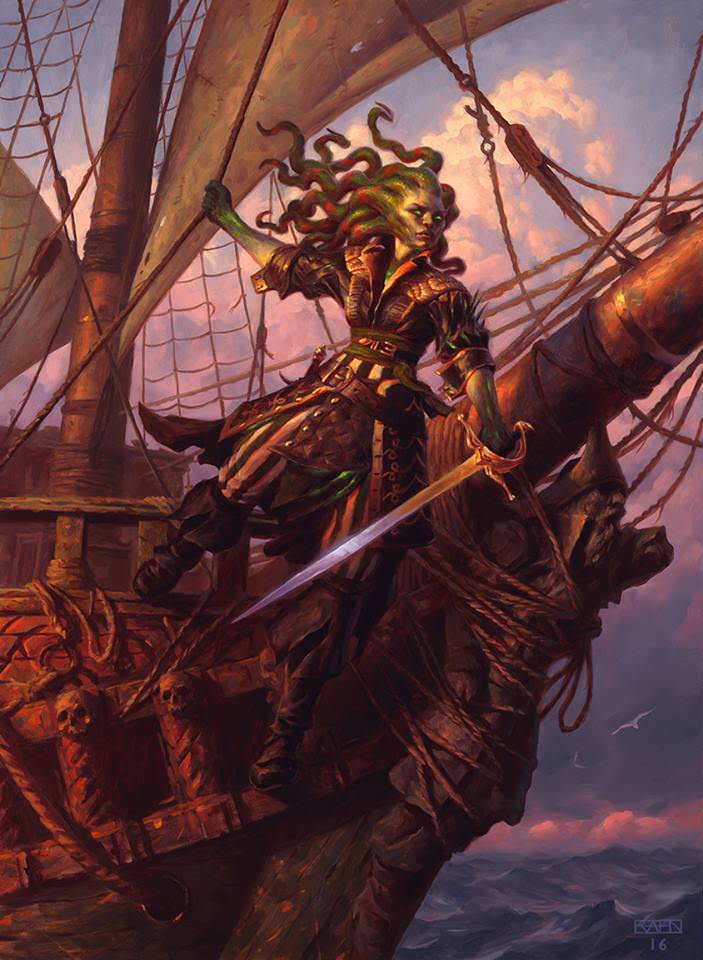

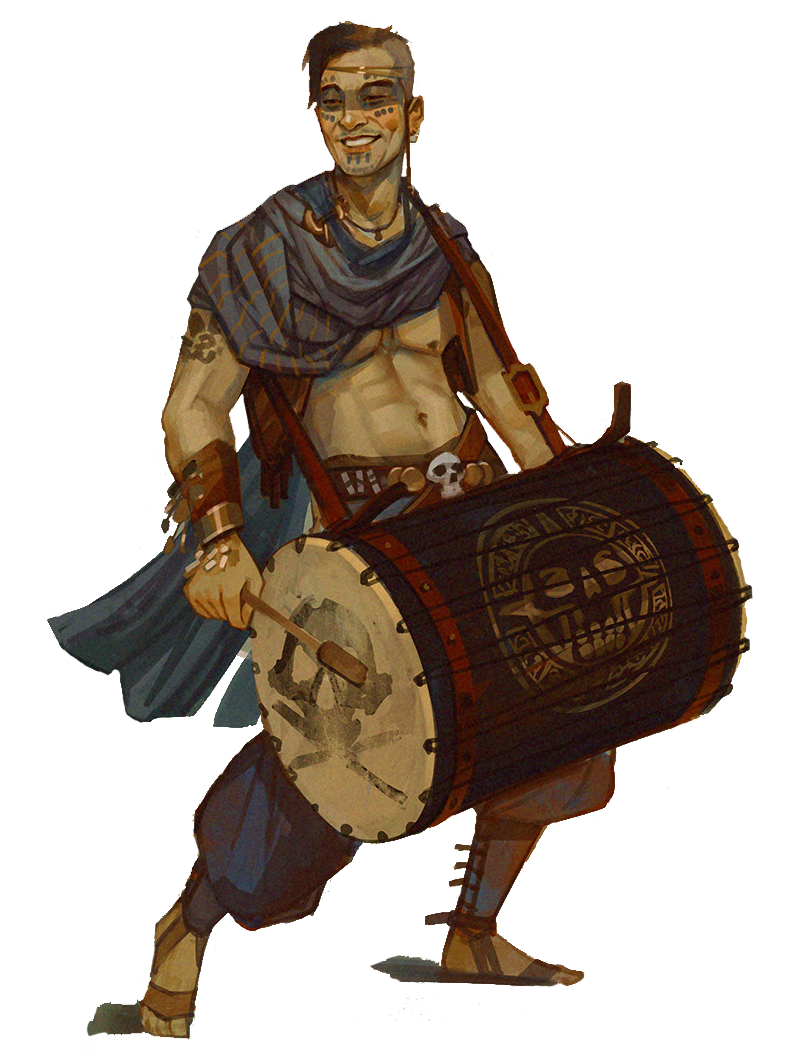
The Lunar Domain
Selune, the goddess of the moon favors champions and worshipers that exemplify balance in all aspects. She teaches that every aspect of life has push and pull, and that both must be maintained for the world to continue forward. Clerics of Selune often favor the Lunar Domain. Stoic champions who are masters of front line combat.
Lunar Domain Features
| Cleric Level | Feature |
|---|---|
| 1st | Domain Spells, Bonus Proficiency, Eclipsing Strike |
| 2nd | Channel Divinity: Lunar Reflection |
| 6th | Wax and Wane |
| 8th | Divine Strike (1d8) |
| 14th | Divine Strike (2d8) |
| 17th | Eclipsing Presence |
Lunar Domain Spells
You gain domain spells at the cleric levels listed in the Lunar Domain Spells table. See the Divine Domain class feature for how domain spells work.
Lunar Domain Spells
| Cleric Level | Spells |
|---|---|
| 1st | divine favor, protection from evil and good |
| 3rd | branding smite, moonbeam |
| 5th | crusader's mantle, tidal wave |
| 7th | banishment, control water |
| 9th | dispel evil and good, holy weapon |
Bonus Proficiency
When you choose this domain at 1st level, you gain proficiency with martial weapons.
Eclipsing Strike
At 1st level, you have learned how to amplify your martial prowess with divine fury. When you cast a spell of 1st level or higher using an action, you may make a melee weapon attack as a bonus action.
You may use this feature a number of times equal to your Wisdom modifier (minimum of one). You regain all expended uses when you finish a long rest.
Chanel Divinity: Lunar Reflection
Starting at 2nd level, you can use your Channel Divinity to enhance your battle prowess.
As an action, you make a spectral duplicate of a weapon you are currently wielding. For the next minute, or until you end the effect with a bonus action, the spectral weapon hovers at your side. Once on your turn when you hit a creature with the weapon you chose to duplicate, it deals an additional die of radiant damage.
For example; if you choose a battle axe, your melee attack deals 1d8 (1d10 versatile) + Strength slashing damage. Your spectral weapon would then deal 1d8 (1d10 versatile) radiant damage.
Wax and Wane
At 6th level, you gain the ability to create moonlight and use it to better control the battlefield. As a bonus action, you create a mote of glowing moonlight that hovers above your head and moves with you for 1 minute. When you create this light, you choose Wax or Wane.
If you choose Wax, the mote emits bright light in a 30 foot radius. When you cast a spell that targets an ally standing within this light, they gain temporary hit points equal to 2 + the spell's level.
If you choose Wane, the mote emits dim light in a 30 foot radius. Enemies that are standing within this light move at half speed and suffer 1d6 radiant damage whenever they deal damage to an ally with an attack.
Once you use this feature, you can't use it again until you finish a short or long rest.
Divine Strike
At 8th level, you gain the ability to infuse your weapon strikes with the divine wrath of Selune. Once on each of your turns when you hit a creature with a weapon attack, you can cause the attack to deal an extra 1d8 radiant damage to the target. When you reach 14th level, the extra damage increases to 2d8.
Eclipsing Presence
Starting at 17th level, you have gained mastery over your lunar presence. When Wax and Wane is active, you can switch which effect is active using a bonus action. Additionally, your Wax and Wane effects gain the following benefits:
- When you activate Wax and Wane, allies within the light gain hit points equal to 5 + your cleric level if Wax is chosen.
- When you activate Wax and Wane, enemies within the light suffer 4d6 radiant damage if Wane is chosen.
- While Wax is active, allies within the light add 1d6 to any saving throws they make.
- While Wane is active, enemies within the light subtract 1d6 from any saving throws they make.
Additionally, while your Channel Divinity: Lunar Reflection is active, it deals additional radiant damage equal to 2 extra damage dice of the weapon selected.
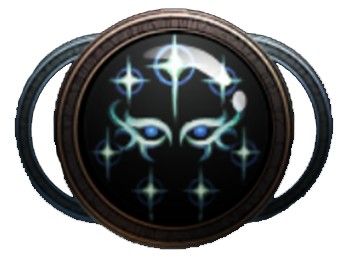
Circle of the Warden
Druids of the Circle of the Warden swear an oath to Melora to protect the wilds from threats both from outside and within. While Druids of other circles focus on ancient lore and magic granted to them by the land or their ability to defend nature as shapeshifters, Druids of the Circle of the Warden channel their mystical abilities into their combat prowess, bolstering their form with the power of the wild.
Some Wardens fight with the swiftness and ferocity of a great cat, striking their foes with their scimitars while dodging nimbly out of harm's way, while other Wardens might overpower their foes with the strength of a bear, knocking them down and pummeling them with a great halberd.
Circle of the Warden Features
| Druid Level | Features |
|---|---|
| 2nd | Melora's Blessing, Aspect of the Wild |
| 6th | Extra Attack |
| 10th | Nature's Flurry |
| 14th | Defender of the Wild |
Melora's Blessing
Starting at 2nd level, Melora blesses you with enhanced endurance. While you are not wearing armor, your Armor Class is equal to 10 + your Dexterity modifier + your
Wisdom modifier.
Additionally, your hit point maximum increases by 2 and increases by 1 whenever you gain a level in this class.
Aspect of the Wild
Beginning at 2nd level, you learn how to channel
your shapeshifting ability to enter a bestial form.
You may expend a use of your Wild Shape
feature to enter a Wild Aspect for 1 minute or until you
use Wild Shape again. While in this form, you gain the following benefits:
- You gain 2 temporary hit points for each level you
have in this class. - Your speed increases by 10 feet.
- You may make opportunity attacks against creatures
within your reach that are standing up from prone. - You gain the Melora's Fury ability.
Melora's Fury. When you hit a creature with a
melee weapon attack, you may expend a Druid spell
slot. The creature suffers an additional 1d6 fire or cold damage and must make a Dexterity saving throw or be knocked prone. The damage of this increases by 1d6 for each spell slot level above 1st.
Extra Attack
Beginning at 6th level, you can attack twice, instead of once, whenever you take the Attack action on your turn.
Nature's Flurry
Starting at 10th level, while your Wild Aspect is active and you move at least 20ft in a straight line toward a creature and take the Attack action against it, you may use your bonus action to make a Shove attack against it. You make this Shove attack at advantage.
Defender of the Wild
Starting at 14th level, when a hostile creature makes an attack against an allied creature that you can see within 30 feet of you, you may use your reaction to cast a spell at that creature. The spell must have a casting time of 1 action and may only target that creature.
You may use this feature a number of times equal to your Wisdom modifier (minimum of one). You regain all expended uses of this feature when you finish a short or long rest.



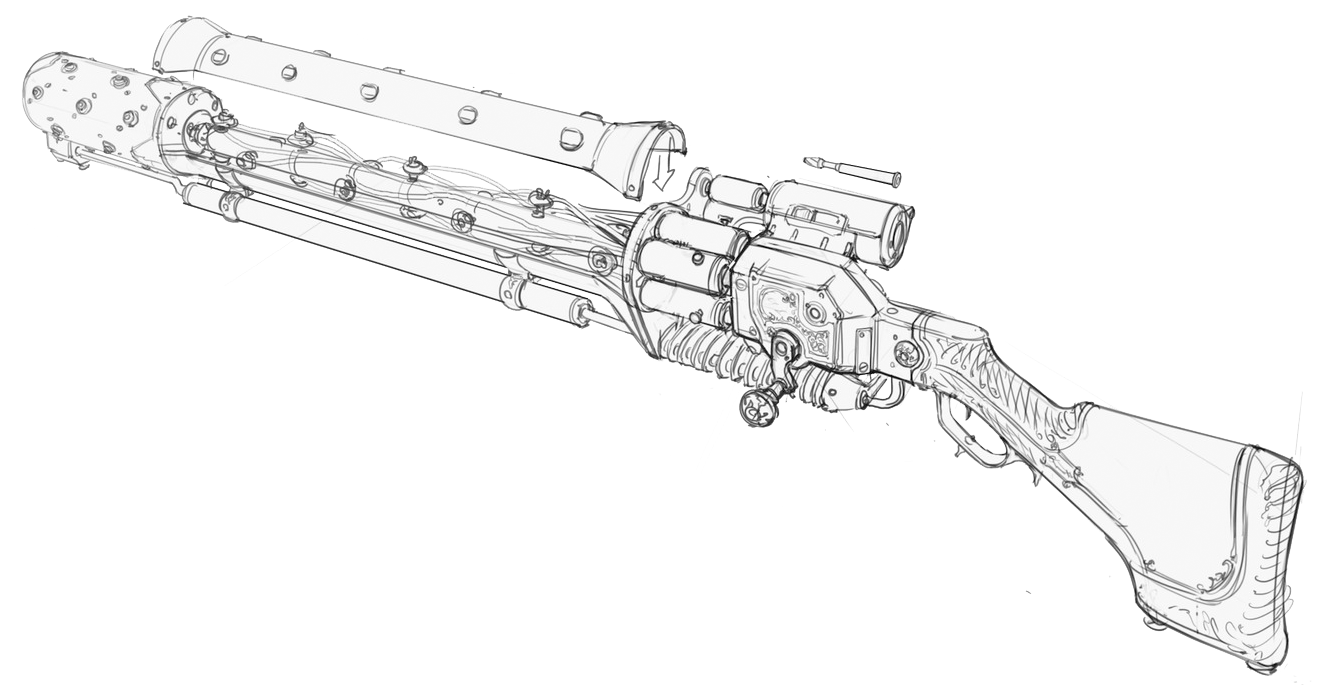
Siegemaster: A Martial Archetype
Markhanis is the capital of innovation and creativity. However, the Ash Walkers had a stroke of genius within the department of war. One night not long ago, a goblin engineer by the name of Darius Rezlo drew up blue prints for a new type of siege weapon. This wasn't just any siege weapon though. Darius had invented what is now called the Ballistola, a portable and highly modular siege cannon.
The Ash Walkers quickly outfitted soldiers with this new weapon to combat the incursion of fire giants in the Ashen Peaks. Over the next decade or so, the Ballistola slew many threats and saw the crumbling of giant fortifications surrounding that Eternal Furnace.
The Ballistola is now carried by Siegemasters. An elite and highly trained unit of Ash Walker. They are tasked with cutting down large threats in the peaks and have recently been sent under contract to help with larger than life problems across Valindris.
Siegemaster Features
| Fighter Level | Feature |
|---|---|
| 3rd | Weapons Expert, Ballistola Upgrades (2) |
| 7th | Behemoth's Bane, No Time to Bleed, Ballistola Upgrade (3) |
| 10th | Ballistola Upgrade (4) |
| 15th | Demolitions Expert, Ballistola Upgrade (5) |
| 18th | Ballistola Upgrade (6), Masterwork Upgrade |
Weapons Expert
When you choose this archetype at 3rd level, you have begun to master the Ballistola. You have been issued a Ballistola from the Ash Walkers. You also gain proficiency with firearms (including your Ballistola) and Tinker's Tools, which you can use to upgrade, repair, and modify your weapon.
Additionally you can reload your Ballistola as a bonus action on your turn.
The statistics for a Ballistola are listed at the end of this archetype.
Ballistola Upgrades
At 3rd level, you have begun to tinker with your weapon. When you gain this feature, you receive two Ballistola Upgrades (see "Ballistola Upgrade Options" below).
You gain an additional Ballistola Upgrade option of your choice when you reach certain levels in this class: 7th, 10th, 15th, and 18th level.
Behemoth's Bane
Starting at 7th level, you have become an expert at taking down large threats. You gain a +1 attack bonus for each size category above medium your target is.
Additionally, you can make opportunity attacks against Huge or larger creatures using your Ballistola.
No Time to Bleed
At 7th level, you have learned how to treat your injuries while on the run. When you use the Second Wind feature, your movement doesn't provoke opportunity attacks for the rest of your turn.
Demolitions Expert
At 15th level, you have mastered how to best lay siege to fortifications. When you deal damage to an object or structure, you deal an additional die of weapon damage.
Masterwork Upgrade
At 18th level, you have come up with an idea to powerfully upgrade your weapon. Over the course of a 8 hour period, you work on your weapon and install one of the following Masterwork Upgrades.
- Heavy Rounds. Your weapon now deals 1d12 damage per attack instead of 1d10. It holds one fewer rounds though (Reload 3).
- Precision Barrel. Your weapon attacks score a critical hit on a roll of 18, 19, or 20.
- Arc Generator. You weapon generates ammunition. You no longer have to reload, but your misfire score increases by 3.
Only one Masterwork Upgrade can be installed to a Ballistola. If you receive a new Ballistola, you can install a new Masterwork Upgrade into that weapon.
Ballistola Upgrade Options
If an upgrade has a prerequisite, you must meet it to learn the upgrade. You can learn the upgrade at the same time that you meet its prerequisite. A level prerequisite refers to your level in this class. When you are able to install a new upgrade, you can also replace an upgrade you already have with a new one. Only one of each upgrade can be installed unless otherwise stated.
If an upgrade requires a creature to make a saving throw, your Siegemaster DC is equal to 8 + your proficiency bonus + your Strength or Dexterity (your choice) modifier.
Anchor Launcher
When you take the attack action on your turn, you can substitute one of the attacks for an Anchor Shot. This attack deals 1d6 piercing damage, and lodges a steel cord into the target that is tethered to the Anchor Launcher.
As long as a creature is tethered, it can move no further than 30 feet from you without making an opposed Strength check against you. On the creatures turn, it can use its action to attempt to dislodge the round by making a Strength check against your Siegemaster DC.
As a bonus action while a creature or object is tethered, you may fire the bolt holding the other end of the cord into the ground. The creature is now tethered to that point.
You are able to make up to 2 of these during a long rest and can carry no more then 2.
Smoke Rounds
As an action, you can load and fire a smoke round at a point you can see within your weapons range. This round copies the effect of a fog cloud spell cast at 1st level.
You are able to make up to 3 of these during a long rest and can carry no more then 3.
Arcane Capacitor Mk. 1
Prerequisite: 7th level
Your Ballistola is considered a +1 weapon.
Arcane Capacitor Mk. 2
Prerequisite: 10th level, Arcane Capacitor Mk. 1
Your Ballistola is considered a +2 weapon.
Arcane Capacitor Mk. 3
Prerequisite: 15th level, Arcane Capacitor Mk. 2
Your Ballistola is considered a +3 weapon.
Stability Handle
You can use your bonus action to grant yourself advantage on the next attack you make.
Levistus Module
Prerequisite: 10th level
As an action, you load a tank filled with arcane frost and launch it from your Ballistola. Each creature within a 15 foot cone in front of you must make a Constitution saving throw. A creature takes 4d6 cold damage on a failed save, or half as much on a successful one.
You may use this once before needing to recharge the module during a short or long rest.
Bolas Launcher
When you take the attack action on your turn, you can substitute one of the attacks for a Bolas shot. If this attack hits, the target must make a Dexterity saving throw or be knocked prone.
Tar Round
As an action, you can load and fire a tar round at a point within 60 feet. The ground in a 10 foot radius around the point becomes difficult terrain. Any creatures in the area when the round hits or that enter the area must make a Dexterity saving throw or become restrained.
A restrained creature can free themselves with an Athletics or Acrobatics check against your Siegemaster DC.
Ionized Conductor
Once per turn when you attack, you deal an additional 1d6 lightning damage.
Muffled Hinges
You no longer make Dexterity (stealth) checks at disadvantage while carrying your Ballistola.
Overloaded Wiring
Prerequisite: 10th level, Ionized Conductor
As a bonus action, you are able to overload your Ionized Conductor for 1 minute. While it is overloaded, your attacks deal an additional 1d8 lightning damage. Once this effect ends, the Ionized Conductor overheats and stops functioning.
It requires a DC 15 Tinker's Tools (dexterity) check and 30 minutes worth of work to repair. You can also repair it with no Tinker's Tools check over a 3 hour period.
Quick Breakdown Lever
Prerequisite: 7th level
You can now make Tinker's Tools checks to repair your weapon as a bonus action.
The Ballistola
Damage: 1d10 bludgeoning
Range: (100/400)
Weight: 50 lbs
Cost: N/A
Properties: Reload 4, Misfire 2, Heavy, Two-handed, Siege, Loud, Unwieldy
- Loud: You make Dexterity (stealth) checks at disadvantage while carrying this weapon.
- Unwieldy: If your Strength score is lower than 13, you move at half speed while wielding this weapon.
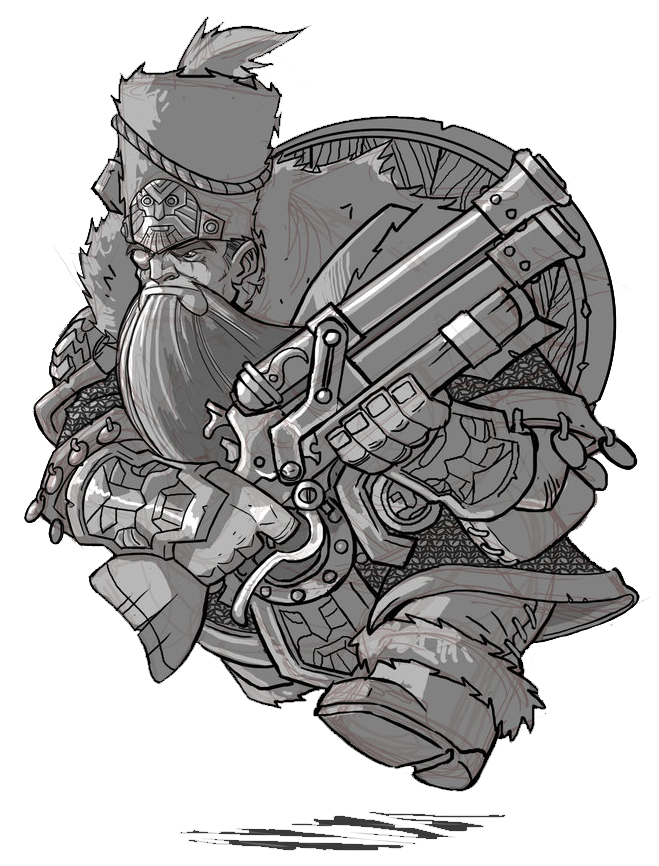


Way of the Mistweaver
Monks of the Jade Monastery have mastered the art of Mistweaving. Through this martial art style, these monks are able to intertwine their ki force with the life force of others. They are able to provide much needed aid in battle while still delivering fearsome strikes of the palm and heel.
Mistweavers are often calm and collected, even in the face of great peril. They have also mastered the art of brewing teas and ales. Jade Wind tea and Xuen's Fang (an ale) are highly sought after in cities across the world and often fetch a purse of gold if they can be found.
Way of the Mistweaver Features
| Monk Level | Feature |
|---|---|
| 3rd | Bonus Proficiencies, Renewing Mists |
| 6th | Expel Harm |
| 11th | Jade Cocoon |
| 17th | Yu'lon's Breath |
Bonus Proficiencies
When you choose this tradition at 3rd level, you gain proficiency with brewer's supplies and the healer's kit if you don't already have them.
Renewing Mists
At 3rd level, you learn how to channel the ki of yourself and those who oppose you in order to heal the injured. When you use Flurry of Blows, you may expend 1 additional ki point to heal a creature that you can see within 30 feet for half of the damage you dealt with Flurry of Blows.
Expel Harm
Beginning at 6th level, you learn how to use your ki to expel harmful effects from those around you. As an action, you may spend 3 ki to copy the effects of a lesser restoration spell.
Beginning at 11th level, you are able to spend 6 ki to copy the effects of a greater restoration spell.
Jade Cocoon
Starting at 11th level, you are able to use your lightning quick reflexes to protect those around you from harm. When a creature you can see within 30 feet of you is attacked, you may use your reaction and spend up to 5 ki points to encase them in a protective cocoon of mist. The creature gains 1d8 temporary hit points per ki spent.
Additionally, any creature that has temporary hit points from this feature receives healing from your Renewing Mists feature equal to the full damage you dealt with Flurry of Blows.
Once you use this feature, you cannot use it again until you finish a short or long rest.
Yu'lon's Breath
At 17th level, your mastery of restorative mists has become unparalleled. As an action, you may spend up to 6 ki to heal those around you. Any creature of your choice within 30 feet is healed for 1d6 per ki spent.

Oath of the Flame
The Oath of the Flame sets a paladin on a perilous path to keep a balance between the prime material plane and the elemental plane of fire. These paladins are the first line of defense against creatures that find their way to the material plane from the plane of fire. They make up a cryptic and mysterious order of warriors that fight with a divine fire.
Tenets of the Flame
The tenets of the Oath of the Flame are a strict code of conduct that ensure the paladin maintains a vigilant watch over barriers between the material and fire planes.
Douse the Flame. Do not let elemental fire burn wild in the material plane. Banish it back to the elemental plane of fire, or stomp it out with force.
Maintain Secrecy. The world at large needs not know of your deeds. Only seek the help of outsiders when circumstances are dire.
Courage Above All. The flame does not flicker with cowardace. Neither should you. Stand with courage, and fight with bravery.
Defend From Flame. Others see chaos and destruction in the flames. You see nothing that can harm you. Ensure others are protected from the flame, even at the cost of yourself.
Oath of the Flame Features
| Paladin Level | Feature |
|---|---|
| 3rd | Oath Spells, Channel Divinity |
| 7th | Aura of Cinders (10 ft.) |
| 15th | Consecrated Ground |
| 18th | Aura of Cinders (30 ft.) |
| 20th | Flamekeeper's Vestige |
Oath Spells
You gain oath spells at the paladin levels listed in the Oath of the Flame Spells table. See the Sacred Oath class feature for how oath spells work.
Oath of the Flame Spells
| Paladin Level | Spells |
|---|---|
| 3rd | absorb elements, burning hands |
| 5th | flaming sphere, warding bond |
| 9th | fireball, protection from energy |
| 13th | banishment, fire shield |
| 17th | dispel evil and good, immolation |
Channel Divinity
When you take this oath at 3rd level, you gain the following two Channel Divinity options.
Blazing Weapon. As an action, you imbue one weapon that you are holding with divine fire, using your Channel Divinity. For 1 minute, one attack per turn deals an additional 1d6 fire damage. The weapon also emits bright light in a 20 foot radius and dim light 20 feet beyond that.
Dousing Strike. You can use your Channel Divinity to strike hard against a creature native to the elemental plane of fire (elementals, fire giants, fire salamanders, hell hounds, among others). When you hit such a creature with an attack, you can use your reaction to give the creature vulnerability to the attack.
Aura of Cinders
Beginning at 7th level, you exude a swirling aura of cinders and ash. You and friendly creatures within 10 feet of you have resistance to fire damage and enemy creatures that suffer an attack of opportunity within the aura suffer fire damage equal to your Charisma modifier (minimum of one).
At 18th level, the range of this aura increases to 30 feet.
Consecrated Ground
Starting at 15th level, you can consecrate the ground under you causing it to harm your enemies and help your allies. As a bonus action, you cause your Aura of Cinders to consecrate the ground. This area moves with you and lasts for 1 minute.
Enemies who start their turn in the area suffer radiant or fire damage (your choice) equal to your Charisma modifier (minimum of one).
While this feature is active, your Lay on Hands heals for an additional amount of hit points equal to half your paladin level at no additional cost to your Lay on Hands pool of healing.
Once your use this feature, you cannot use it again until you finish a long rest.
Flamekeeper's Vestige
At 20th level, you are able to call forth the blazing regalia of the Flamekeeper and wreath your body in divine fire. As an action, you wreath your body in flames for 1 minute and gain the following effects:
- You shed bright light in a 30 foot radius and dim light 30 feet beyond that.
- You gain immunity to fire damage.
- A creature that attacks you suffers fire or radiant damage equal to your Charisma modifier (minimum of one).
- Your attacks gain advantage against creatures of the plane of fire.
- Your attacks deal an additional 10 fire or radiant damage.
Once you use this feature, you can't use it again until you finish a long rest.
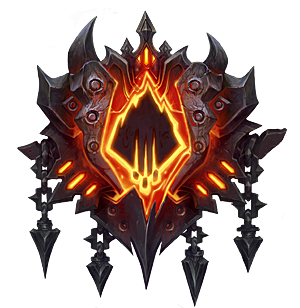


The Corsair: A Ranger Archetype
Corsairs of the Freehold Brotherhood are feared all across the seas of Valindris. These pirates are fast, ruthless, and tactical in their pursuit of riches. These rangers are at home on the deck of a ship sailing across the oceans of the world. They have learned that not much in life is more important than having the winds at your back, and a clear mark ahead of you.
Corsair Features
| Ranger Level | Feature |
|---|---|
| 3rd | Corsair Magic, Sealegs, Boarding Party |
| 7th | Iron Belly |
| 11th | Run Through |
| 15th | Fancy Footwork |
Corsair Magic
Starting at 3rd level, you learn an additional spell when you reach certain levels in this class, as shown in the Corsair Spells table. The spell counts as a ranger spell for you, but it doesn't count against the number of ranger spells you know.
Corsair Spells
| Ranger Level | Spell |
|---|---|
| 3rd | cause fear |
| 5th | rope trick |
| 9th | enemies abound |
| 13th | leomund's secret chest |
| 17th | control winds |
Sealegs
At 3rd level, you have made yourself at home on the open sea. You gain a climb and swim speed of 30 feet. You also gain proficiency with firearms and Navigator's Tools.
Additionally, your proficiency bonus is doubled for any checks you make using Navigator's Tools.
Boarding Party
Beginning at 3rd level, you have learned how to efficiently and quickly find weaknesses in your enemy's defenses, and can point them out. When you roll initiative, as long as you are not surprised, you can grant a bonus to another creature's initiative within 15 feet of you equal to your Wisdom modifier (minimum of one). A creature granted this bonus makes attacks in the first round of combat at advantage if they act before their target.
Iron Belly
At 7th level, your time at sea living off of rations and rum has made you hardier. You gain proficiency in Constitution saving throws and you make saving throws to resist poison and disease at advantage.
Run Through
Starting at 11th level, you have perfected your ruthlessness in combat. When you attack a creature, it deals an additional 1d10 weapon damage as long as you have attacked that creature before on the current turn.
Fancy Footwork
Beginning at 17th level, your speed and alertness in battle gives pause to attackers. Any creature attacking you does so at disadvantage if they have used any movement before making their attack.
Additionally, when you are subjected to an effect that allows you to make a Dexterity saving throw to take only half damage, you instead take no damage if you succeed on the saving throw, and only half damage if you fail.
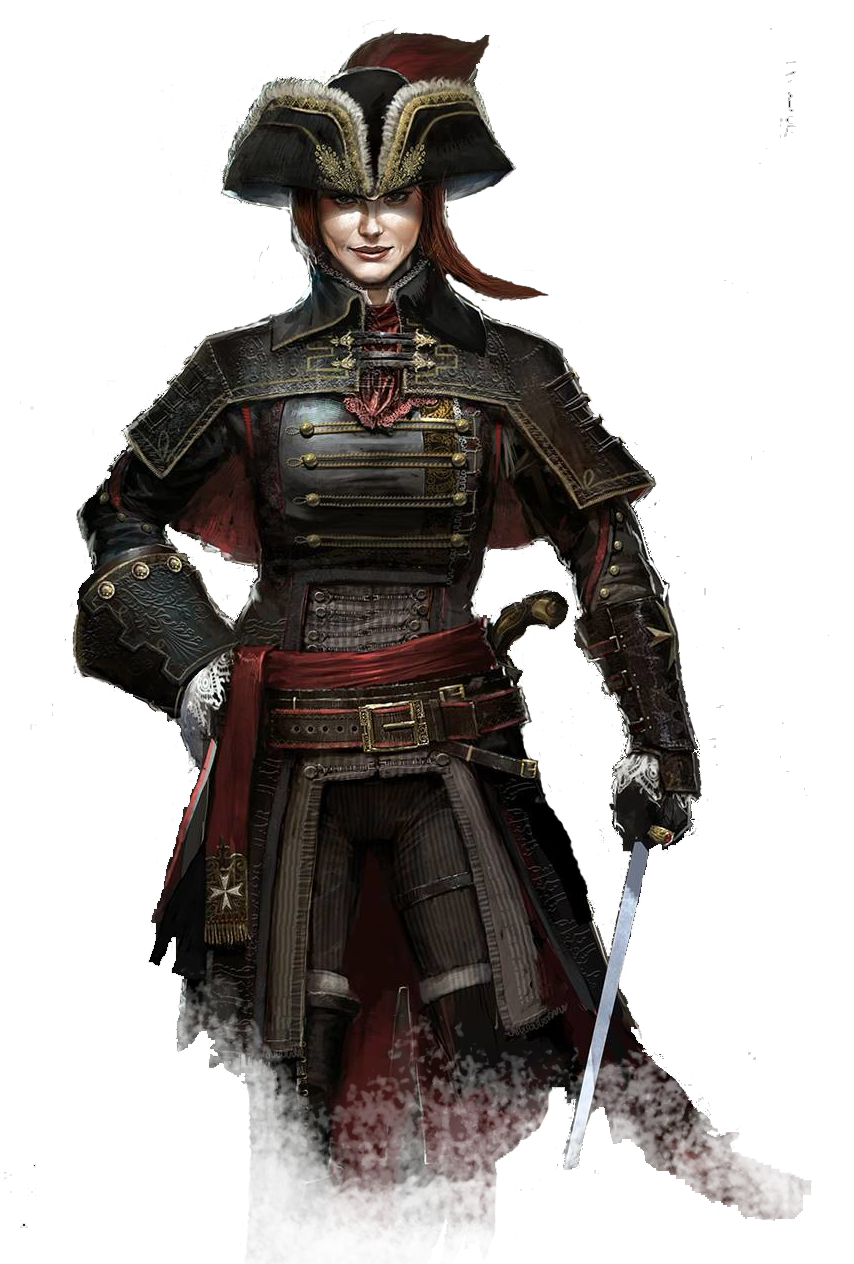
Outlaw: A Rouge Archetype
You have honed your skills with not only the blade, but with small firearms. While some rogues sneak silently through shadow, you prefer to walk a path of chaos and revelry.
An Outlaw is a brazen fighter who calls upon the blessing of lady luck and the Pirate Queen to quicken their strikes and harden their resolve.
Outlaw Features
| Rogue Level | Feature |
|---|---|
| 3rd | Versatile Cutthroat, Roll the Bones |
| 9th | Between the Eyes, Loaded Dice |
| 13th | Hit and Run |
| 17th | Adrenaline Rush |
Versatile Cutthroat
When you choose this archetype at 3rd level, you gain a keen understanding of firearms. You gain proficiency with firearms and tinkerers tools. As long as you are wielding a pistol, you may ignore the loading property of that weapon. Additionally, you can attempt to unjam a firearm as a cunning action.
Roll the Bones
Starting at 3rd level, you may call upon the Pirate Queen to grant you a temporary boon. You have a pool of d6s that you can spend to bargain for luck or power. The number of dice in the pool equals your rogue level.
As a bonus action, you can spend a number of dice up to half of your rogue level and roll them on the Roll the Bones table below. The effects you gain from the table remain active for a number of turns equal to the number of dice rolled or until you expend dice to roll on the table again.
You regain all expended dice when you complete a long rest.
Roll the Bones
| d6 | Effect |
|---|---|
| 1 | Buried Treasure: Your movement speed increases by 10 feet and you ignore difficult terrain. |
| 2 | Broadsides: Your attacks deal additional damage equal to your Charisma modifier (minimum 0). |
| 3 | Grand Melee: When you sneak attack, you gain temporary hit points equal to the dice rolled. |
| 4 | Shark Infested Waters: You score a critical hit on a roll of 19 or 20 on the attack roll. |
| 5 | True Bearing: You gain an additional bonus action that may only be used for your cunning actions. |
| 6 | Jolly Roger: Once on your turn when you miss with an attack roll, you may choose to roll with advantage. |
Between the Eyes
At 9th level, you have learned how to focus your aim in order to cause extreme disruption in your foes.
When you deal sneak attack damage with an attack from a pistol, the creature hit must make a Constitution saving throw (Saving throw DC is equal to 8 + your proficiency bonus + your Dexterity modifier). On a failure, the creature is stunned until the end of your next turn. Once you use this feature, you must finish a short or long rest before using it again.
Loaded Dice
Additionally at 9th level, you are able to bend luck in your favor. When you Roll the Bones, you may reroll up to 2 dice. You may use this feature a number of time equal to your Charisma modifier (minimum 1). When you complete a long rest, you regain any expended uses.
Hit and Run
Starting at 13th level, your movement speed is increased by 15 feet after hitting a creature with an attack with a pistol.
Adrenaline Rush
Beginning at 17th level, you have learned how to heighten all of your senses and quicken your reflexes, allowing you to move like a blur and strike like lightning. On your turn, you may enter an Adrenaline Rush for 1 minute or until to you end it using a bonus action. While under the effects of Adrenaline Rush, you gain the following benefits:
- Your Armor Class increases by 2.
- You gain one additional action on your turn. This action can be used to make one attack, dash, disengage, hide, or use an item.
- When you Roll the Bones, you roll one additional d6 and you may reroll one of the die.
- Your Sneak Attack damage increases by 3d6.
When you take damage while under the effects of Adrenaline Rush, you must succeed on a Constitution saving throw to maintain the effect. The DC is equal to 10 or half of the damage taken, whichever is higher. If you fail this saving throw, Adrenaline Rush ends and you have disadvantage on all attack rolls, ability checks, and saving throws you make until the end of your next turn. Once you use this feature, you can't do so again until you finish a long rest.


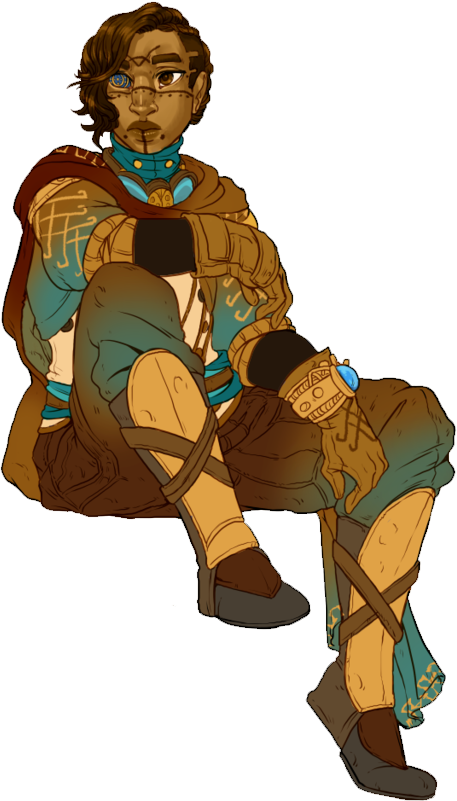
Seeker's Soul: A Sorcerous Origin
Many sorcerers gain their arcane nature from some powerful being in their lineage, or the blessing of their soul by some divine power. Your soul however, has been touched by some great wandering spirit. A being of the old world, before the floods and chaos.
Along with the magic you have been granted, there is also a great curiosity for relics and ruins of the past. An almost incurable wanderlust and a need to seek out that which has been hidden by time.
Seeker's Soul Features
| Sorcerer Level | Feature |
|---|---|
| 1st | Seeker Spells, Wanderer's Mind |
| 6th | Careful Footing |
| 14th | Hidden Steps |
| 18th | Knowledge Beyond Time |
Seeker Spells
Beginning at 1st level and at certain levels after that, you gain the ability to cast spells specific to the Seeker's Soul. Once you gain an origin spell, you always know it, and it doesn't count against the number of spells you know. If you have an origin spell that doesn't appear on the sorcerer spell list, the spell is a sorcerer spell for you.
Seeker Spells
| Sorcerer Level | Spell |
|---|---|
| 1st | identify |
| 3rd | locate object |
| 5th | water breathing |
| 7th | arcane eye |
| 9th | legend lore |
| 11th | find the path |
Wanderer's Mind
At 1st level, you learn the easier ways to traverse the world. You gain proficiency with Intelligence (History), Navigator's tools, and Cartographer's tools.
Additionally, when you make an Intelligence (History), Intelligence (Investigation), or Wisdom (Perception) check to gain knowledge of a historical site or relic, you can choose to roll at advantage. You can use this feature 3 times. You gain all expended uses when you finish a long rest.
Careful Footing
Starting at 6th level, you have learned to tread carefully within the ruins of the past. As a bonus action, you can spend 2 sorcery points to surround yourself with floating spectral lights for 1 minute. These lights emit bright light in a 20 foot radius around you. If this light comes into contact with a trap (such as a trip wire, or pressure plate) it will dim as the lights float over to highlight the trap.
Additionally, if you would take damage from a trap, you can use your reaction to grant yourself resistance to that damage. Once you use this feature, you must complete a short or long rest before using it again.
Knowledge Beyond Time
At 18th level, you gain a mastery over your
inherent magical abilities. You are able to empower
your Seeker Spells by spending sorcery points when
you cast one. The spells gain the following effects:
- Identify. You can maintain concentration on this spell for
2 minutes per sorcery point spent, up to a maximum of 10 minutes. While this spell is active, you can identify items as an action. - Locate Object. You can extend the range of this spell by 1 mile for 5 sorcery points. Additionally, you can locate an object that you know the name and description of.
- Water Breathing. You can grant creatures effected by this spell a swim speed of 30 feet if they don't already have one for 3 sorcery points per creature.
- Arcane Eye. You can hear through the eye for 5 sorcery points.
- Legend Lore. For 8 sorcery points, you can ask a question about the lore you learn and receive and answer as per the commune spell.
- Find the Path. For 5 sorcery points, you no longer need an object from the location in order to cast the spell.
Pact of the Depths: An otherworldly patron
Throughout the world, there are some warlocks who strike a deal with some manner of creature from the depths of the oceans. This deal is sometimes struck with a supremely powerful Ancient Kraken, or sometimes some unseen horror lurking far beneath the surface. These warlocks are widely regarded as heretics and outcasts though, since it is widely believed that any power they draw from the seas stems from the Drowned One, or what is left of his forces.
Pact of the Depths Features
| Warlock Level | Feature |
|---|---|
| 1st | Expanded Spell List, Gift of the Depths, Doom |
| 6th | Tidal Shift |
| 10th | Grasp of the Deep |
| 14th | The Terror Below |
Expanded Spell List
The Pact of the Depths lets you choose from an expanded list of spells when you learn a warlock spell. The following spells are added to the warlock spell list for you
| Spell Level | Spells |
|---|---|
| 1st | create or destroy water, ray of sickness |
| 2nd | blur, moonbeam |
| 3rd | tidal wave, water breathing |
| 4th | control water, watery sphere |
| 5th | destructive wave, maelstrom |
Gift of the Depths
At 1st level, your patron bestows upon you the strength of the depths. You gain a swim speed of 30 feet. Additionally, you do not suffer disadvantage on rolls from being submerged in water and you ignore difficult terrain that is caused by water.
Doom
Starting at 1st level, you can call upon your patron to bestow a powerful curse. When you hit a creature with an attack, you can curse them with Doom as a bonus action. The creature makes a Constitution saving throw against your spell save DC. On a failed save, the creature is cursed for 3 rounds. At the end of that creatures turn, it takes 1d6 necrotic damage and repeats its saving throw to try and end Doom. If the curse continues, it does an additional 1d6 necrotic damage each round it is active. A creature who succeeds on their saving throw is immune to this effect for 24 hours.
You may only have 1 curse active at a time.
Tidal Shift
Beginning at 6th level, your understanding of the tides allows you to summon water to shield you and batter foes. Whenever a creature hits you with an attack, you can use your reaction to grant yourself resistance to the damage it deals. The creature then takes bludgeoning damage equal to the damage you take from the attack.
Once you use this feature, you can't use it again until you finish a short or long rest.
Grasp of the Deep
At 10th level, you can call forth watery tendrils to wade down your enemies. As an action, you summon forth watery tendrils from beneath up to 3 creatures you can see within 30 feet. The creatures must make a Dexterity saving throw against your spell save DC or become restrained. A creature restrained by these tendrils can break free using an action on their turn to make a Strength (athletics) or Dexterity (acrobatics) check (their choice) against your spell save DC.
A creature who is restrained by these tendrils suffers 2d6 bludgeoning damage at the start of their turn. They also gain resistance to fire damage if they didn't already have it, but also gain vulnerability to cold damage if they aren't resistant or immune to it.
Once you use this feature, you can't use it again until you finish a short or long rest.
The Terror Below
Starting at 14th level, you have learned how to manifest the horrors of the deep wherever you are. Once per turn when you hit a creature with an attack, you can expend a Warlock spell slot to open the depths up beneath them. A terrible beast from the depths lunges out of the water at the creature, dealing 6d10 bludgeoning damage as the rift closes.

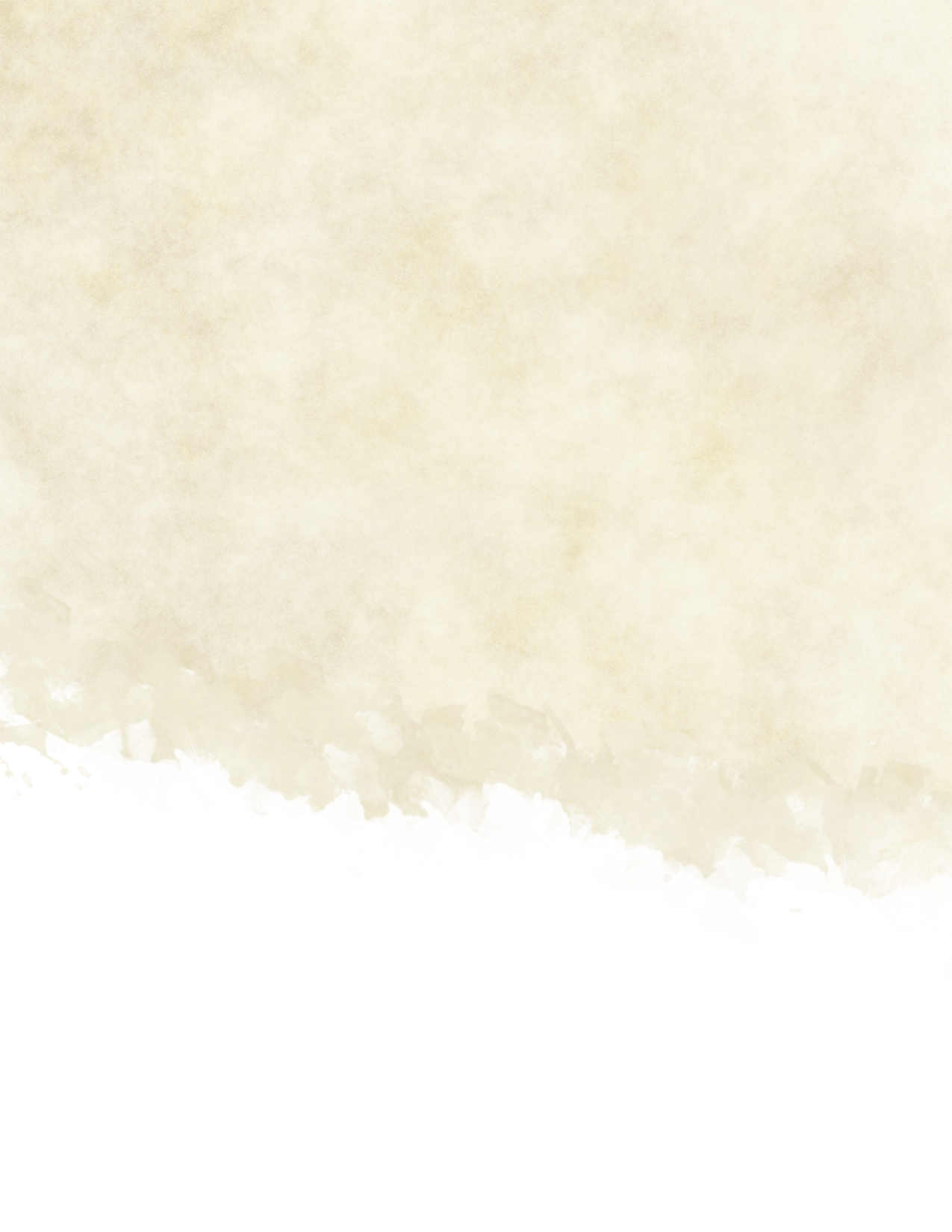
School of Elementalism
Wizards belonging to the School of Elementalism have learned how to bend the elements to their whims. This school of wizardry was founded in Markhanis, by an arcane council that sought a way to calm the elemental tides of Valindris. Eventually, they found a way to bind their arcane natures to one of the elemental planes. This process allowed for them to enhance their own abilities with elemental energy and better combat threats from the elemental planes.
School of Elementalism Features
| Wizard Level | Feature |
|---|---|
| 2nd | Arcane Binding, Primal Speaker |
| 6th | Echo of the Elements |
| 10th | Primordial Call |
| 14th | Ascendance |
Arcane Binding
Starting when you choose this Arcane Tradition at 2nd level, you bind your arcane nature to one of the elemental planes. Choose Air, Earth, Fire, or Water. Your essence is now bound to that elemental plane, which grants you certain benefits detailed in this section. The gold and time you must spend to copy a spell that is native to your elemental plane into your spellbook is halved. The spells native to each plane are detailed at the end of this section.
Once you are bound to a plane, you can spend 10 minutes conducting an arcane ritual. This ritual reveals to you the distance and direction of the closest breach or portal to your chosen elemental plane within 5 miles.
Primal Speaker
Beginning at 2nd level, you learn to speak, read, and write Primordial. Knowing this language allows you to understand and be understood by those who speak its dialects: Aquan, Auran, Ignan, and Terran.
Additionally, when interacting with creatures native to the elemental plane your powers are bound to, you can add your Intelligence modifier (minimum of one) to Charisma based rolls.
Echo of the Elements
At 6th level, the elements echo your displays of power. When you cast a spell from your elemental plane using a Wizard spell slot of 1st level or higher, one of the following happens depending on your chosen elemental plane.
You can use this ability a number of time equal to your Intelligence modifier (minimum of one). You regain all expended uses when you finish a long rest.
Cloudburst. If you deal lightning or thunder damage, the air around you electrifies. Lightning lashes out at creatures of your choosing within 10 feet of you. These creatures must make a Dexterity saving throw, taking 3d8 lightning damage on a failed save, or half as much on a success.
Fury of the Earth. When you deal damage with an earthen spell, 2 earthen bolts follow the spell. You can strike up to 2 creatures that were dealt damage by your spell. Each bolt deals 1d10 bludgeoning damage. These bolts can strike the same or different creatures that were dealt damage by your spell.
Ignite. When you deal fire damage, one enemy continues to burn. At the beginning of that creatures turn, they take 1d10 fire damage and must make a Dexterity saving throw to try and put out the flame. This effect continues until the creature succeeds a saving throw, or fails two.
Frost Nova. One creature you deal cold damage to radiates frozen energy. Creatures within 10 feet of the target (including the target) take 2d6 cold damage and must make a Constitution saving throw or become frozen (restrained) until the end of their next turn.
Primordial Call
Starting at 10th level, the elements grant you a boon to aid in your journey. You gain one of the following benefits depending on your chosen elemental plane.
Air. When you are forced to make a Dexterity saving throw, you can expend one Wizard spell slot to add 1d6 to the saving throw. For every spell slot level above 1st, you add one additional d6. You can choose to do this after making the roll on the d20 but before knowing if you succeed or fail.
Earth. Your gain a +2 bonus to your Armor Class as long as you are not wearing armor. You also gain resistance to poison damage.
Fire. You gain resistance to fire and cold damage.
Water. You gain a swim speed of 30 feet. If you already have a swim speed, it is increased by 10 feet. You can also now breath air or water and don't suffer disadvantage on rolls from being submerged in water.
Ascendance
At 14th level, you have learned how to fuse your being with the primordial energy of your chosen elemental plane. As an action, you enter an elemental form for 1 minute or until you end this effect as a bonus action. While in this state, you gain the following effects.
Air.
- As an action, you can summon an Air Elemental. You can communicate with this elemental telepathically and it obeys your wishes. It lasts until Ascendance ends or it is reduced to 0 hit points, where it returns to its home plane.
- You gain resistance to lightning and thunder damage.
- Ranged attacks have disadvantage against you.
- You gain a fly speed of 30 feet.
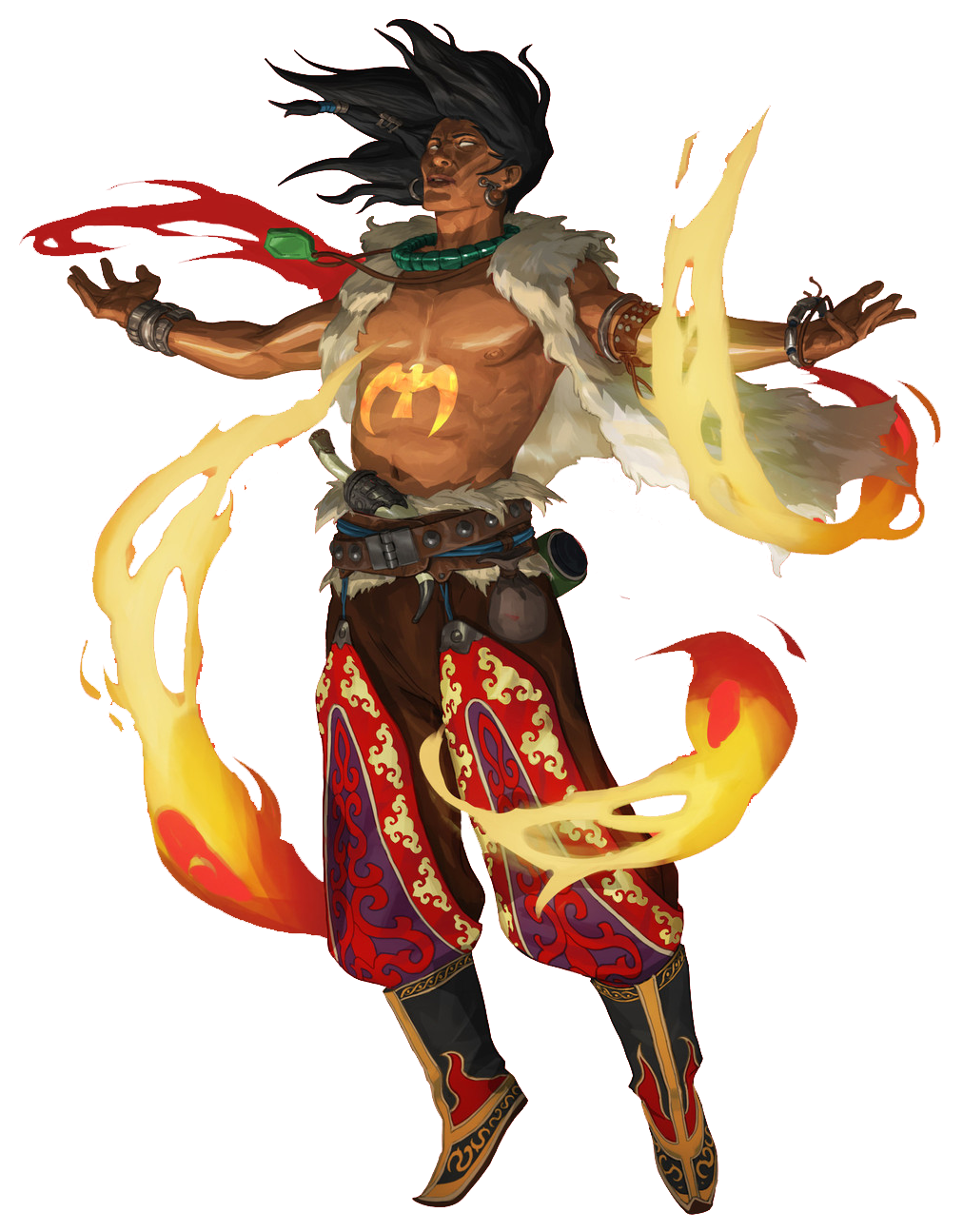
Earth.
- As an action, you can summon an Earth Elemental. You can communicate with this elemental telepathically and it obeys your wishes. It lasts until Ascendance ends or it is reduced to 0 hit points, where it returns to its home plane.
- You gain temporary hit points equal to twice your Wizard level.
- You gain resistance to bludgeoning, piercing, and slashing damage from nonmagical weapons.
- The ground in a 10 foot radius around you becomes difficult terrain. Enemy creatures take 2d8 bludgeoning damage when they end their turn in this space or enter it for the first time in a turn.
Fire.
- As an action, you can summon a Fire Elemental. You can communicate with this elemental telepathically and it obeys your wishes. It lasts until Ascendance ends or it is reduced to 0 hit points, where it returns to its home plane.
- You shed bright light out to 30 feet and dim light for an additional 30 feet.
- When you deal fire damage, you deal additional damage equal to your Intelligence modifier (minimum of one). This can effect multiple creatures.
- Creatures who hit you with a melee attack suffer 2d8 fire damage.
Water.
- As an action, you can summon a Water Elemental. You can communicate with this elemental telepathically and it obeys your wishes. It lasts until Ascendance ends or it is reduced to 0 hit points, where it returns to its home plane.
- You gain resistance to fire damage.
- You surround yourself with a swirling vortex of water that follows behind your spells. When you deal damage with a spell of the water plane, you can cast a Cantrip from the water plane as a bonus action. You add your Intelligence modifier (minimum of one) to the damage of a Cantrip cast in this way.
- When you are injured, the waters surrounding you can become restorative as well. As a bonus action on your turn, you can expend a Wizard spell slot to regain a number of hit points equal to 1d6 per level of the spell slot expended.
Once you use this feature, you must finish a long rest before you can use it again.

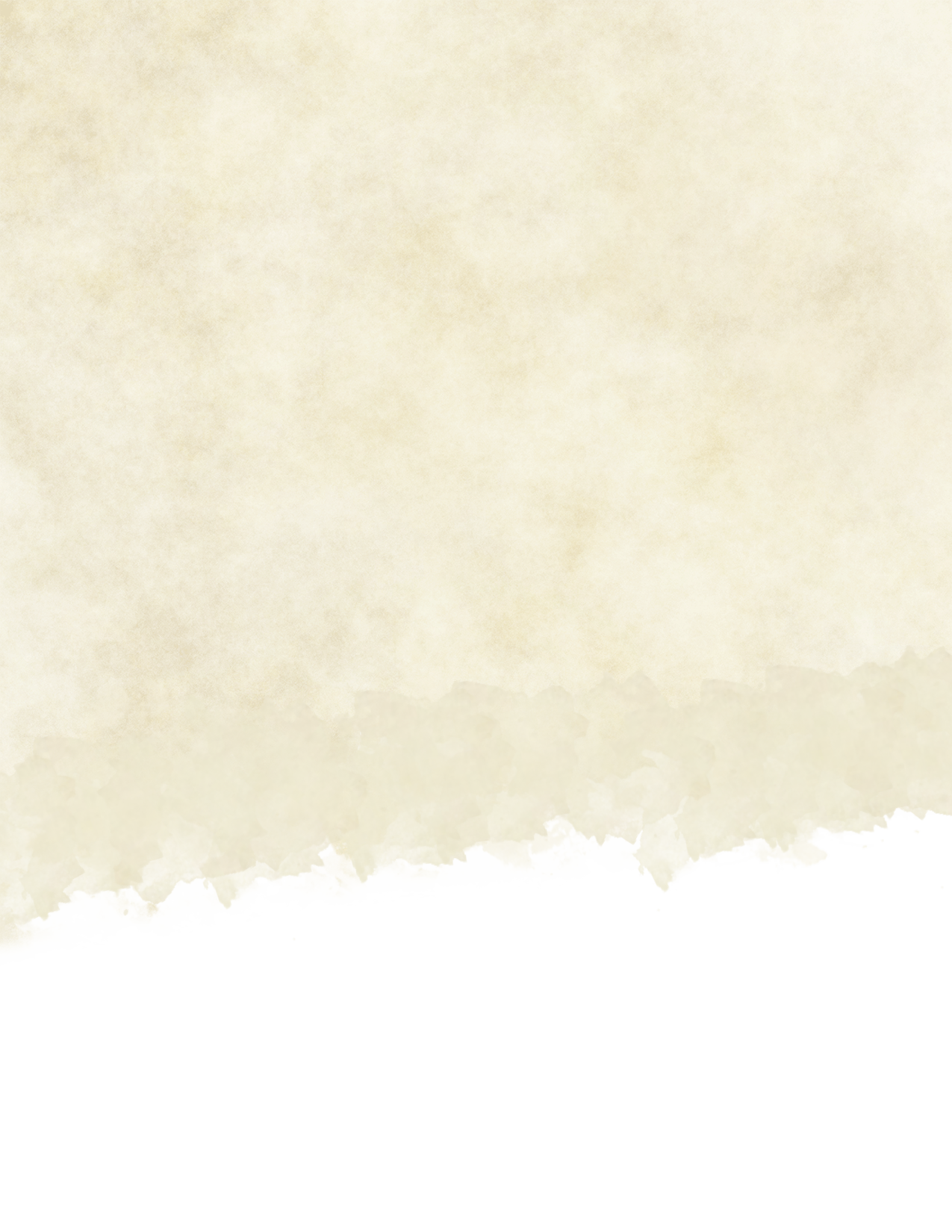
Air Spells
Cantrips (0 Level)
- Gust
- Shocking Grasp
- Thunderclap
1st Level
- Absorb Elements
- Chromatic Orb
- Expeditious Retreat
- Feather Fall
- Fog Cloud
- Thunderwave
- Witch Bolt
2nd Level
- Dragon's Breath
- Dust Devil
- Gust of Wind
- Invisibility
- Levitate
- Misty Step
- Skywrite
- Warding Wind
3rd Level
- Fly
- Gaseous Form
- Haste
- Lightning Bolt
- Protection from Energy
- Thunder Step
4th Level
- Conjure Minor Elementals
- Elemental Bane
- Greater Invisibility
- Storm Sphere
5th Level
- Conjure Elemental
- Control Winds
- Far Step
- Steel Wind Strike
6th Level
- Chain Lightning
- Investiture of Wind
- Scatter
7th Level
- Prismatic Spray
- Reverse Gravity
- Whirlwind
8th Level
- Control Weather
9th Level
- Prismatic Wall


Earth Spells
Cantrips (0 Level)
- Acid Splash
- Mending
- Mold Earth
1st Level
- Absorb Elements
- Chromatic Orb
- Earth Tremor
- False Life
- Shield
- Snare
2nd Level
- Dragon's Breath
- Dust Devil
- Earthbind
- Enlarge/Reduce
- Maximillian's Earthen Grasp
- Melf's Acid Arrow
- Shatter
3rd Level
- Erupting Earth
- Melf's Minute Meteors
- Protection from Energy
- Wall of Sand
4th Level
- Conjure Minor Elementals
- Elemental Bane
- Hallucinatory Terrain
- Stone Shape
- Stoneskin
- Vitriolic Sphere
5th Level
- Cloudkill
- Conjure Elemental
- Passwall
- Transmute Rock
- Wall of Stone
6th Level
- Create Homunculus
- Flesh to Stone
- Investiture of Stone
- Move Earth
- Tenser's Transformation
7th Level
- Prismatic Spray
8th Level
- Mighty Fortress
9th Level
- Prismatic Wall
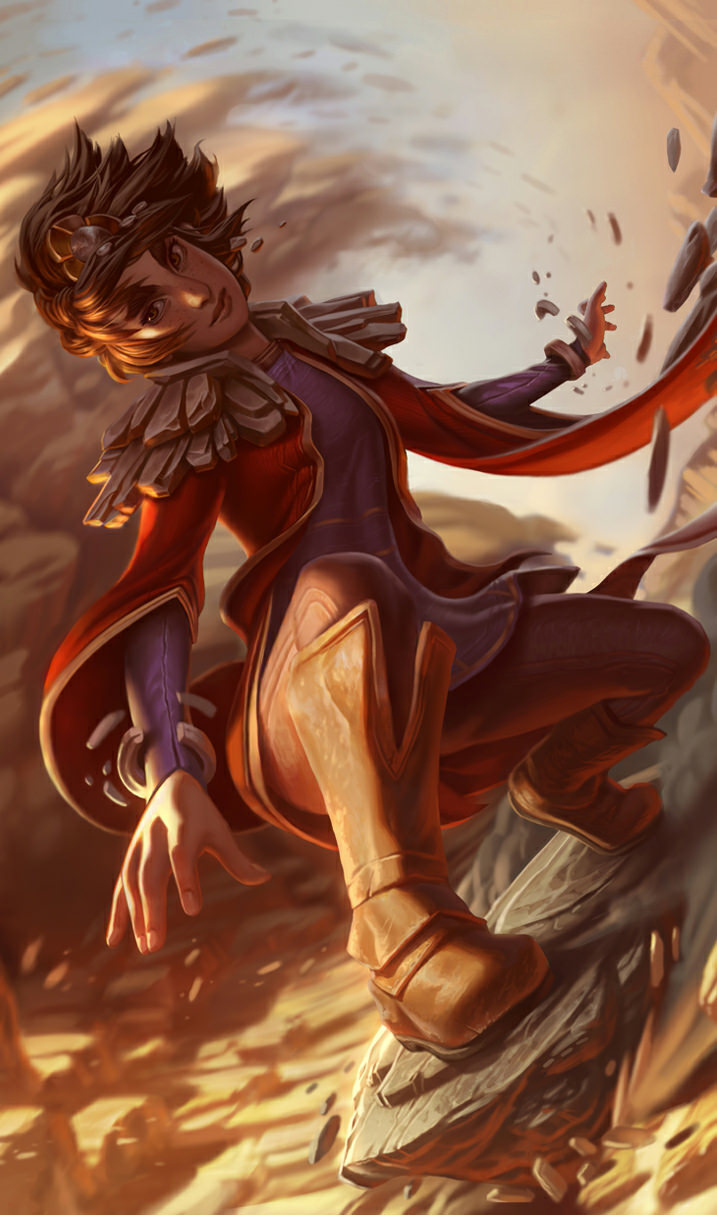

Fire Spells
Cantrips (0 Level)
- Create Bonfire
- Control Flames
- Fire Bolt
1st Level
- Absorb Elements
- Burning Hands
- Chromatic Orb
2nd Level
- Agnazzar's Scorcher
- Continual Flame
- Dragon's Breath
- Flaming Sphere
- Pyrotechnics
- Scorching Ray
3rd Level
- Fireball
- Flame Arrows
- Melf's Minute Meteors
- Protection from Energy
4th Level
- Conjure Minor Elementals
- Elemental Bane
- Fire Shield
- Wall of Fire
5th Level
- Conjure Elemental
- Dawn
- Immolation
- Wall of Light
6th Level
- Investiture of Flame
- Sunbeam
7th Level
- Delayed Blast Fireball
- Prismatic Spray
8th Level
- Incendiary Cloud
- Sunburst
9th Level
- Prismatic Wall
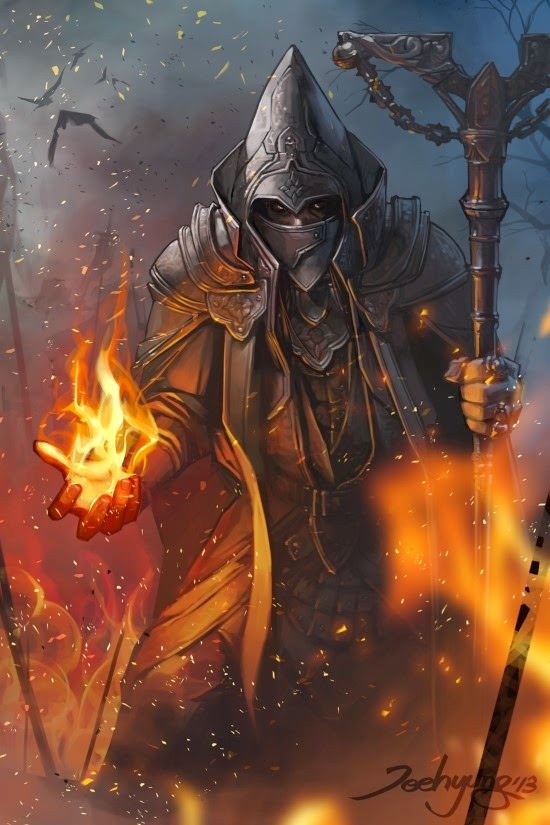

Water Spells
Cantrips (0 Level)
- Chill Touch
- Frostbite
- Ray of Frost
- Shape Water
1st Level
- Absorb Elements
- Chromatic Orb
- Ice Knife
2nd Level
- Darkness
- Dragon's Breath
- Hold Person
- Snilloc's Snowball Swarm
3rd Level
- Protection from Energy
- Sleet Storm
- Slow
- Tidal Wave
- Wall of Water
- Water Breathing
4th Level
- Conjure Minor Elementals
- Control Water
- Elemental Bane
- Ice Storm
- Watery Sphere
5th Level
- Cone of Cold
- Conjure Elemental
- Hold Monster
6th Level
- Investiture of Ice
- Otiluke's Freezing Sphere
- Wall of Ice
7th Level
- Prismatic Spray
- Whirlwind
8th Level
- Control Weather
9th Level
- Prismatic Wall


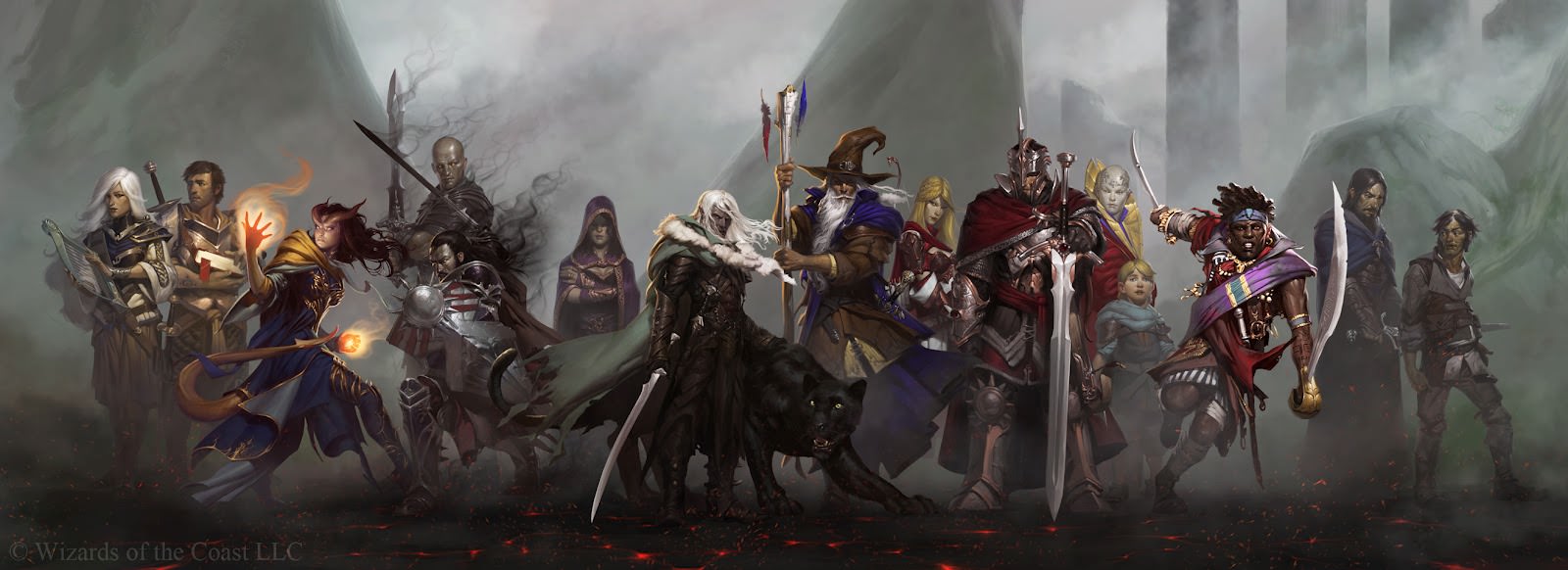

The Races of Valindris
The world of Valindris is inhabited by most of the races you'll find in the Forgotten Realms with a few exceptions and a few additions. Here are a list of the races of the world along with a few notes about some of them.
Common Races
- Dwarf (Hill, Mountain)
- Elf (Wood, High, Half)
- Genasi (Water) *
- Goblin *
- Goliath
- Halfling (Lightfoot, Stout)
- Human
Uncommon Races
- Elves (Drow, Eladrin) *
- Genasi (Air, Earth, Fire) *
- Gnomes (Forest, Rock)
- Gorgon *
- Lizardfolk *
- Triton
Rare Races
- Aasimar
- Bronzeforged (Warforged) *
- Dwarfs (Duergar)
- Half Orc *
- Tiefling
Goblins
In Valindris, Goblins are not a hyper violent primitive race. They are actually a highly intelligent race that typically favors large cities. They have become some of the world's leading engineers and inventors, some even leading a Markhesian Guild.
- Goblins in this setting can increase their Constitution or Intelligence score by 1 at character creation.
- Goblins in this setting gain the ability Time is Money. Once per short or long rest, they can gain advantage on a Charisma check to negotiate with a merchant or trader.
Elves - The Drow and Eladrin
When Valindris flooded, most of the large caverns that stretched far below the surface stood no chance against the surge of water. Luckily for the Drow, a large portion of their capital city was evacuated. The drow now mostly stick to a life in either Markhanis or Hoten.
The Eladrin have grown wildly in population over the past 200 or so years. The appearance of the Bay of Dreams and it's fey influence over part of the world is believed to be the cause for this. Eladrin can be found all over the world. They prefer to live free lives filled with exploration and wonder.
The Genasi
Ever since the barrier between the material plane and the elemental plane of water was torn open, there has been an increased presence of elementals. And with that, came a gradual influx of Water Genasi throughout the world. You're hard pressed to find a merchant, transport, or military ship that doesn't have at least a handful of Water Genasi among their crew.
Similarly in the southern isles, the barrier between the material plane and the elemental plane of fire is growing thin. Because of this, there has been a steady increase in the population of Fire Genasi throughout the region.
To the northeast lies the Jade Forest, where monks of the Jade Monastery guard the entrance to the elemental plane of air. These monks have always had a small number of Air Genasi among their roster.
Half-Orcs and Lizardfolk
Unfortunately for the Orcs of Valindris, they did not adapt to life after the floods. When the waters came, the Orc tribes hunkered down and prayed to their gods. The seas ravaged Gor'Tok and Grund, the two largest settlements of Orcs.
A few Orcs survived the flood and adapted to their new lives. Most of these Orcs were forced to integrate with other races in order to survive. One of the most prominent places where this happened was in the city of Omaht Zalar, the capital of the lizardfolk's kingdom in Zehr'esh.
The result of this absorption of Orcs long ago worked out wonderfully for the lizardfolk. The Orcs began to train lizardfolk in the ways of military tactics, while the lizardfolk helped educate the Orcs in the ways of nature and the spirits.
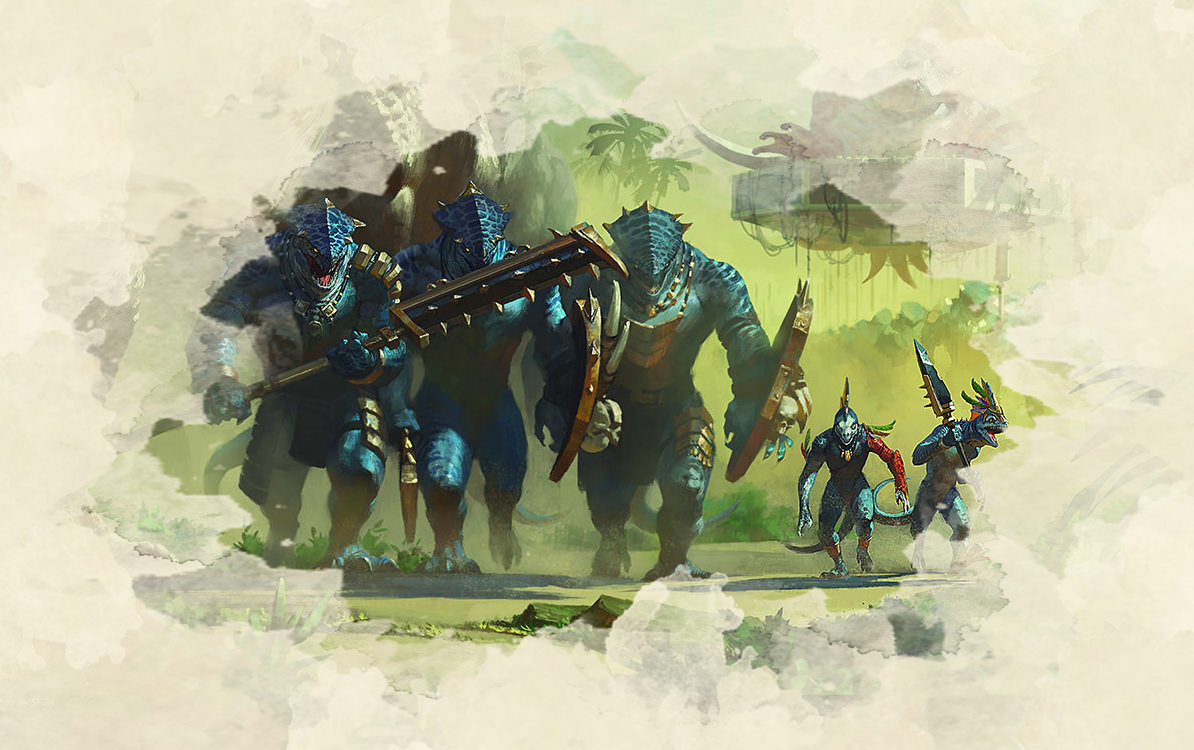
Lizardfolk
The lizardfolk of Zehr'esh were once part of the great empire of Zalar. Part of their empire was crushed by Agda Jand, and the rest by the floods. Now they reside in the city of Omaht Zalar in the center of Zehr'esh's largest island. It is here they worship in their temples to the Loa spirits and conduct trade in the open marketplaces.
The lizardfolk of Valindris have evolved slightly over the centuries since they took in orcish refugees. The orcs began training the lizardfolk in tactical warfare and strength, something they did not lack before, but did not posses on the same level as the orcs. They have also managed to overcome a stigma they once held against the softer skinned races of the world.
The lizardfolk now send merchants and traders all around the world. Herbs found within Zehr'esh's jungles and the hides of beasts found there fetch a good price in Markhanis. Meanwhile, the southern district of Caetirym is being run by a prominent lizardfolk.
The Spirits of the World
The lizardfolk of Valindris worship the spirits of the Loa. A mystical being inhabiting some other plane of existence that has taken on the mantle of an animal or beastial spirit. The lizardfolk consult the Loa about all manner of things, from insight into ship routes to the best strategy to use when fighting back the threats of the jungle.
Many lizardfolk view the Loas like other races view their gods. The Loa are sacred creatures that demand respect. Creatures showing disrespect towards them are often the targets of the lizardfolk's anger. After all, that crime is punishable by death in Omaht Zalar.
Lizardfolk Traits
As a Lizardfolk, you have the following traits.
Ability Score Increase. Your Constitution score increases by 1.
Age. Lizardfolk reach maturity around age 15 and rarely live longer than 70 years.
Alignment. Most lizardfolk are neutral. They see the world as a place of predators and prey, where life and death is a natural process.
Speed. Your base walking speed is 30 feet, and you have a swimming speed of 30 feet.
Cunning Artisan. As part of a short rest, you can harvest bone and hide from a slain creature to create one of the following items: a shield, a club, a javelin, or 1d4 darts. To use this trait, you need a blade or appropriate artisan's tool.
Hold Breath. You can hold your breath for up to 15 minutes at a time.
Natural Armor. You have tough, scaly skin. When you aren't wearing armor, your AC is 13 + your Dexterity modifier.
Languages. You can speak, read, and write Common, Orc, and Draconic.
Subrace. Two subraces of lizardfolk exist: saurus lizardfolk and skink lizardfolk. Choose one of them for your character.
Saurus Lizardfolk
Saurus lizardfolk are a stronger breed that more closely resembles the dinosaurs of the Zehr'eshi jungles.
Ability Score Increase. Your Strength score increases by 2.
Size. Saurus lizardfolk are slightly larger than humans. Your size is medium.
Bite. Your fanged maw is a natural weapon which you can make unarmed strikes with. If you hit with it, you deal piercing damage equal to 1d6 + your Strength modifier.
Imposing Presence. You gain proficiency in the Intimidation skill.
Hungry Jaws. As a bonus action, you can make a special attack with your bite. If the attack hits, it deals its normal damage and you gain temporary hit points equal to your Constitution modifier (minimum of one), and you can't use this trait again until you finish a short or long rest.
Skink Lizardfolk
Skink lizardfolk are a much smaller more agile breed of lizardfolk.
Ability Score Increase. Your Dexterity score increases by 2.
Size. Skink lizardfolk are much smaller than humans. Your size is small.
Agile Predator. Your movement speed is increased by 5 feet and you gain a climbing speed of 20 feet.
Rake. You have a long raptor like talon extending from each of your feet, which you can make unarmed strikes with. If you hit with it, you deal slashing damage equal to 1d4 + your Dexterity modifier.
Hunter's Lore. You gian proficiency with two of the following skills: Animal Handling, Nature, Perception, Stealth, and Survival.
Pack Tactics. You have advantage on attack rolls against a creature if at least one of your allies is within 5 feet of the creature and the ally isn't incapacitated.
Bronzeforged
Roughly 15 years ago, Dromthar Cogwhistle, a brilliant Dwarven inventor, came up with the plans for a new type of automated assistant. He called his invention Bronzeforged. Dromthar's arcane labs and factory in Markhanis quickly went to work perfecting the design and producing workin models.
Just 7 years ago, the first of these automated assistants hit the Markhesian markets. Most people have yet to see one of these marvels, though word of Dromthar's invention has spread throughout Valindris quickly. The latest model of Bronzeforged was stamped with the serial number 0038B.
The Bronzeforge were created to serve the upper class of Markhanis as perfect assistants and workers. They have not been in production long, but after making 38, Dromthar Cogwhistle has slowed production after receiving complaints that the Bronzeforged were showing signs of life. They displayed a full range of emotions, free thought, and social bonds. Some within the upper echelon of Markhanis have begun to question if the Bronzeforged actually possess souls.
Traits
As a Bronzeforged, you have the following traits.
Ability Score Increase. Your Strength and Constitution scores increase by 1.
Age. It is unknown how long Bronzeforged live for yet. Dromthat suspects a lifespan of 500 years though.
Alignment. Bronzeforged lean toward lawfulness, though they have no predisposition for good, neutral, or evil behavior.
Size. You are the same size as a Dwarf. You are medium.
Speed. Your base walking speed is 25 feet.
Darkvision. Your focusing lenses grant you Darkvision
out to a range of 60 feet.
Made With Purpose. You gain proficiency in one
artisan tool of your choice.
Bronze Plating. Your construction incorporates
bronze and composite metals, granting you a +1 bonus
to Armor Class.
Living Construct. Even though you are a construct,
you are a living creature. You are immune to disease.
You do not need to eat or breathe, but you can ingest
food and drink if you wish.
Instead of sleeping, you enter an inactive mode for
4 hours each day. You do not dream in this state; you
are fully aware of your surroundings and notice
approaching creatures or other events as normal.
Languages. You can speak, read, and write Common, Dwarf, and one other language of your choice.


Other Races
Most of the world will get fleshed out as players begin to explore and take action. There shouldn't be any reason to strictly exclude a race that someone wants to play. Most races that are not in this section can still easily be fit into the world of Valindris.
Gorgon
Long ago, An'Jaret was a grand and illustrious kingdom in the heart of Ahnkalla. It was lead by Medusa, a powerful arcane race of woman with snakes for hair that with a glare could turn men to stone. Their kingdom reigned for centuries and was a feared force throughout Valindris. Eventually, An'Jaret was brought down by the Rakshasa that eventually built their empire near Ahnkalla. For centuries, the Medusa were held captive by the Rakshasa and used for anything imaginable. The abuse and continual enslavement lead to the Medusa losing much of their magical nature, reducing them to what is today known as the Gorgon.
The Gorgon are a powerful race of women with serpentine tendrils for hair. While they do not wield the same power as their ancestors, they still have a fierce magical nature. They are now scattered about the world and make for some awesome tales. Ves'Ri the Pursuer is a legendary pirate queen, Drav'Ga is the senator put forth by the Alchemy Guild in Markhanis, and Yn'Tha is one of the only Ash Walkers who has infiltrated the Eternal Furnace.
Traits
As a Gorgon, you have the following traits.
Ability Score Increase. Your Constitution score increases by 2. Additionally, your Dexterity or Intelligence score increases by 1.
Age. Gorgon reach adulthood around 20 and can live up to 200 years. They show no signs of visible age past their late 50s.
Alignment. Gorgon typically lean towards lawful alignments. Most are neutral, though evil Gorgon are not uncommon.
Size. Gorgon are roughly the same size as humans. You are medium.
Speed. Your base walking speed is 30 feet.
Darkvision. You gain Darkvision out to a range of 60 feet.
Arcane Ancestry. You know the prestidigitation cantrip. Once you reach 3rd level, you can cast the disguise self spell once per day. Once you reach 5th level, you can also cast the hold person spell once per day. Intelligence is your spellcasting ability for these spells.
Languages. You can speak, read, and write Common, Elvish, and one extra language of your choice.
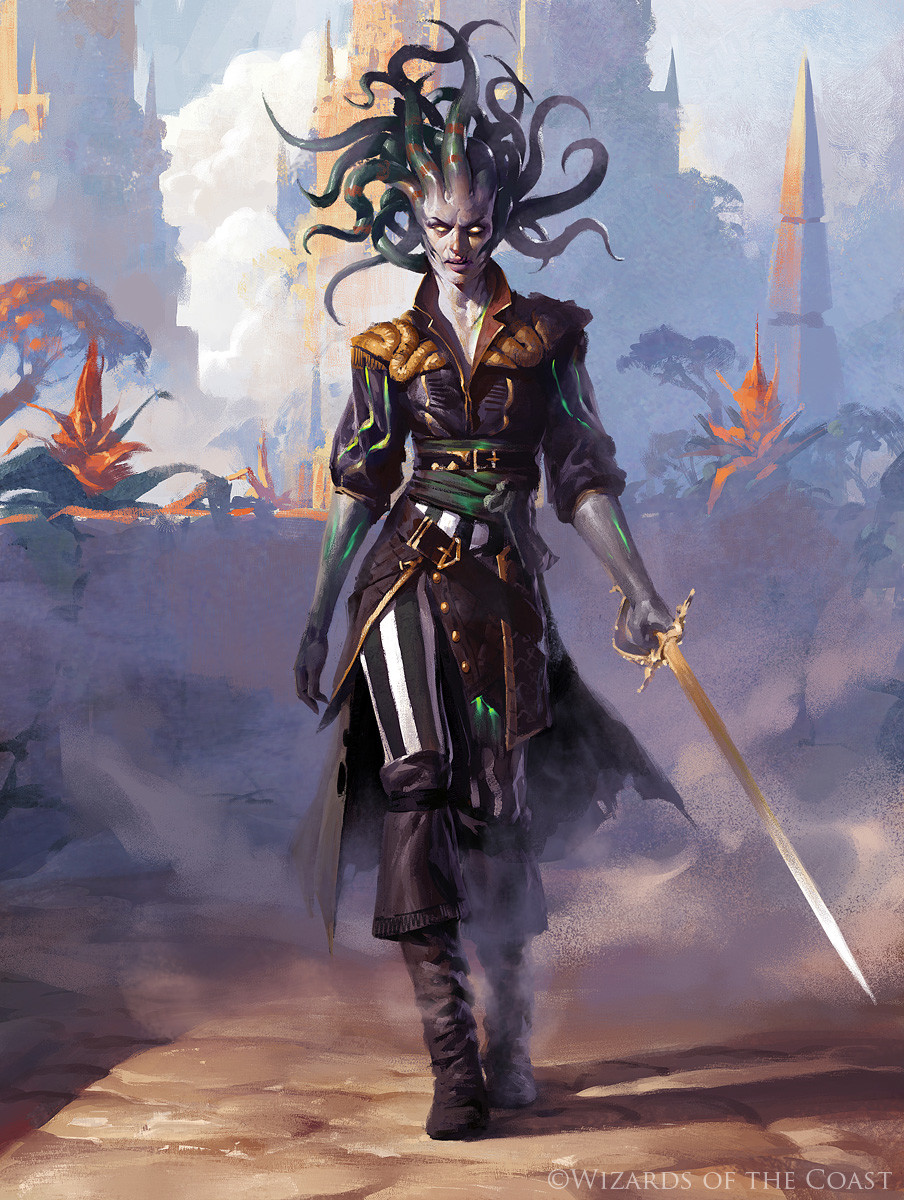

Firearms
| Weapon | Cost | Damage | Weight | Range | Properties |
|---|---|---|---|---|---|
| Light Pistol | 75gp | 1d6 piercing | 2 lbs | (15/60) | Reload 1, Misfire 1, Light |
| Trick Pistol | 250gp | 2d4 piercing | 2 lbs | (30/60) | Reload 3, Misfire 3, Light |
| Pistol | 200gp | 1d10 piercing | 3 lbs | (100/400) | Reload 4, Misfire 1 |
| Pepperbox | 450gp | 1d10 piercing | 5 lbs | (150/600) | Reload 6, Misfire 2 |
| Musket | 450gp | 1d12 piercing | 10 lbs | (200/800) | Two-handed, Reload 1, Misfire 2 |
| Blunderbuss | 400gp | 1d8 piercing | 10 lbs | (15/30) | Two-handed, Reload 1, Misfire 3, Scatter |
| Long Rife | 750gp | 1d12 piercing | 15 lbs | (300/1000) | Two-handed, Reload 1, Misfire 3 |
| Mortar | 1,250gp | 4d10 fire(20 ft) | 90 lbs | (120-1,200) | Mounted, Reload 1, Misfire 1, Trajectory, Explosive, Siege |
| Swivel Gun | 1,500gp | 3d8 bludgeoning | 85 lbs | (200/1,200) | Mounted, Reload 1, Misfire 1, Slow, Siege |
| Cannon | 3,500gp | 8d10 bludgeoning | 2,500 lbs | (600/2,400) | Mounted, Reload 1, Misfire 1, Slow, Siege |
Firearms
Firearms and blackpowder are fairly common within Valindris. This setting uses the rules developed by Matthew Mercer in the Gunslinger Martial Archetype with a few new features and modifications. Listed below are many of the common types of guns with their properties.
Firearm Properties
Some properties are followed by a number. This number signifies an element of that property, outlined below.
Reload. The weapon can be fired a number of times equal to its Reload score before you must spend 1 attack or 1 action to reload. You must have one free hand to reload a firearm.
Misfire. Whenever you make an attack with this firearm, and the dice roll is equal to or lower than the misfire score, the weapon misfires. The attack misses, and the weapon cannot be used again until you spend an action to try and repair it.
To repair your firearm, you must make a successful Repair (Dexterity) check (DC equal to 8 + misfire score). You may add your proficiency to this check if you are proficient with Tinker's tools.
Scatter. An attack is made against each creature within a 15 foot cone. If an affected creature is adjacent to you, they suffer double damage on a hit. Creatures beyond 15 feet from you but within 30 feet must make a Dexterity saving throw (DC equal to 8 + your firearm attack bonus) or suffer half of the damage.
Explosive. Upon a hit, everything within 5 feet of the target must make a Dexterity saving throw (DC equal to 8 + your firearm attack bonus) or suffer the attacks damage on a failed save, or half as much on a success.
Mounted. A mounted weapon must be firmly mounted to fire. These are usually heavy and unwieldy weapons that would wreak havoc on the surrounding area if not mounted.
Slow. Reloading these weapons requires 3 actions. They can be taken by 1 person over 3 turns, or by 3 people on 1 turn.
Trajectory. These weapons aren't aimed traditionally. Instead, coordinates are calculated and dialed into the weapon, which fires its ammunition in a high arc. Successfully inputing coordinates requires an Intelligence check (with proficiency if proficient in Firearms).
Siege. These weapons deal their full damage to structures and objects, ignoring any Damage Threshold the structure or object has.
Light. These weapons can be used with Two Weapon Fighting.
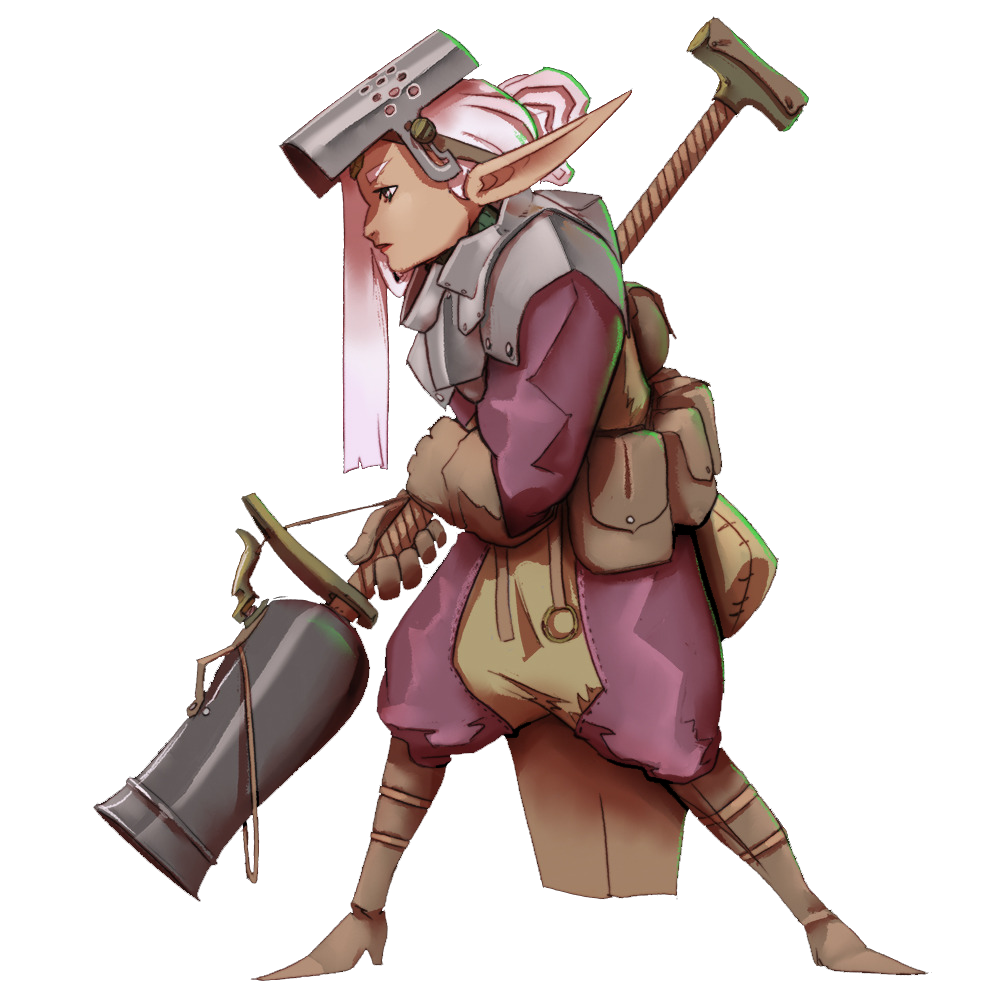
New Feats
These new feats can be taken instead of Ability Score Improvements when you gain a level.
Battle Knowledge
You've learned how to use your wits to time your moves while predicting opponents strikes, making their attacks miss more often. You gain the following benefits:
- Your Intelligence score increases by 1, to a maximum of 20.
- You use your Intelligence instead of your Dexterity when determining your AC and initiative.
Cleave
Prerequisite: 13 Dexterity or 13 Strength or higher
You have learned that a Mighty sweep of your blade should not always be wasted on one opponent.
- On your turn, when you score a critical hit with a melee weapon attack, you can chose another target within reach. Instead of rolling extra dice for the attack’s damage against the first target, you may roll that damage against the second target. Then add any relevant modifiers as normal to both the first and second strike.
- Once on your turn, when you reduce a creature to 0 hit points with a melee weapon attack, you can continue your strike. You may immediately make an attack roll against another creature within reach using the same weapon.
Combat Quickness
You're quick. None can match your speed or your combat prowess. You truly understand what it is to be "fast."
- Your base movement speed increases by 10 feet.
- You gain an additional reaction each round.
- You can use the Dash or Disengage actions as a Bonus Action
- When you are the target of an opportunity attack, you can use your reaction to make a melee weapon attack against the attacker.
Dauntless
Prerequisites: Constitution 13 or higher
You aren't known for giving up. In fact, you never compromise, even in the face of your own defeat. You gain the following benefits:
- When you start your turn, if you have no more than half of your hit points left, you gain temporary hit points equal to 3 plus your Constitution modifier. You do not gain this benefit if you are unconscious or if you have not taken damage since your last turn.
- When you take damage that would reduce you to 0 hit points, you can use your reaction to bolster your willpower. You gain temporary hit points equal to 1d10 plus your level, which take as much of the triggering damage as possible. You lose all temporary hit points gained this way at the start of your next turn. Once you use this feature, you must finish a short or long rest before you can use it again.
Elusive
Prerequisites: Proficiency in Dexterity (Stealth)
You have learned how to dwell among the shadows without raising suspicion. You gain the following benefits
- You have advantage on any Dexterity (Stealth) checks made to hide while you are in dim light or darkness, even if you are hiding from creatures with darkvision or similar senses.
- After you have taken the Hide action, you can move up to your full speed without revealing your position.
- Whenever you roll initiative in dim light or darkness, you can simultaneously take the Hide action if there is an appropriate place to hide within 5 feet of you.
Exact Shooter
Prerequisites: Dexterity 15 or higher and proficiency with a ranged weapon
You gain a +2 bonus to ranged attack rolls with ranged weapons you are proficient with.
When you miss with a ranged weapon attack, you can choose one of the following options:
- Gain an additional +2 to your ranged weapon attack rolls next turn.
- Gain +1 to your damage rolls with ranged weapon attacks next turn.
- Gain and additional 10 feet of movement this turn.
Fencing Expert
Prerequisites: Dexterity 15 or higher and proficiency with a rapier
As a trained fencer, you are skilled at attacking and defending with rapiers. While you are wielding a rapier, you gain the following benefits:
- When you score a critical hit, you can roll an additional 1d6 and add it to the extra damage for the critical hit.
- When you are wielding a rapier in one hand and nothing in your other hand, you gain a +1 bonus to AC
- As a bonus action, you can make a Feinting Move to beguile a hostile creature within 10 feet of you. The creature must make a Wisdom saving throw. The DC equals 8 plus your proficiency bonus plus your Dexterity modifier. On a failed save, you have advantage on the next attack against that creature until the start of your next turn. Whether they succeed or fail, the creature is immune to being affected by this feature again for 1 hour.
Master Gunsmith
You have mastered the art of crafting and repairing firearms. You gain the following benefits
- You gain proficiency with Tinker's Tools. If you already have proficiency it is doubled.
- The Misfire rate of firearms you wield is reduced by 1, to a minimum of 0.
- You can repair firearm misfires as a Bonus Action.
Pack Leader
You imitate the pack tactics of creatures such as kobolds and wolves, and utilize it for your companions. You gain the following benefits:
- When a friendly creature makes a melee attack against a creature that is within 5 feet of you, you can use your reaction to grant advantage on the attack roll.
- When a creature you can see targets you with an attack, you can use your reaction to choose a willing creature within 5 feet of you. You and the chosen creature swap places, and the chosen creature becomes the target instead. Once you use this feature, you must finish a short rest or long rest before you can use it again.
Siege Caster
Prerequisite: The ability to cast at least one spell.
You master the art of breaking things... With magic! You gain the following benefits:
- Your spellcasting ability score increases by 1, to a maximum of 20.
- Your spells that deal damage benefit from the Siege property.
- Against a Construct, your spells deal additional damage equal to your spellcasting ability modifier + half your level.
Tactician
Your experience and study in combat tactics lets you shout out guiding words to aid your allies. You gain the following benefits:
- You learn two of the following maneuvers from those available to the Battlemaster Archetype of the fighter class: Commander's Strike, Distracting Strike, Maneuvering Attack, and Rally. If a maneuver you use requires your target to make a saving throw to resist the maneuver’s effects, the saving throw DC equals 8 + your proficiency bonus + your Strength or Dexterity modifier (your choice).
- If you already have superiority dice, you gain two more; otherwise, you have two superiority die, which are d6s. These dice are used to fuel your maneuvers. A superiority die is expended when you use it. You
regain your expended superiority
dice when you finish a short or
long rest.
- You can give tactical advice to give your allies an edge in combat. When an creature other than yourself within 60 feet of you who can hear you makes an ability check, attack roll, or saving throw, you can use your reaction and expend one superiority die. The creature adds the the number you roll on your superiority die to their roll. You can wait until after it rolls the d20 before deciding to use the superiority die, but must decide before the DM says whether the roll succeeds or fails.
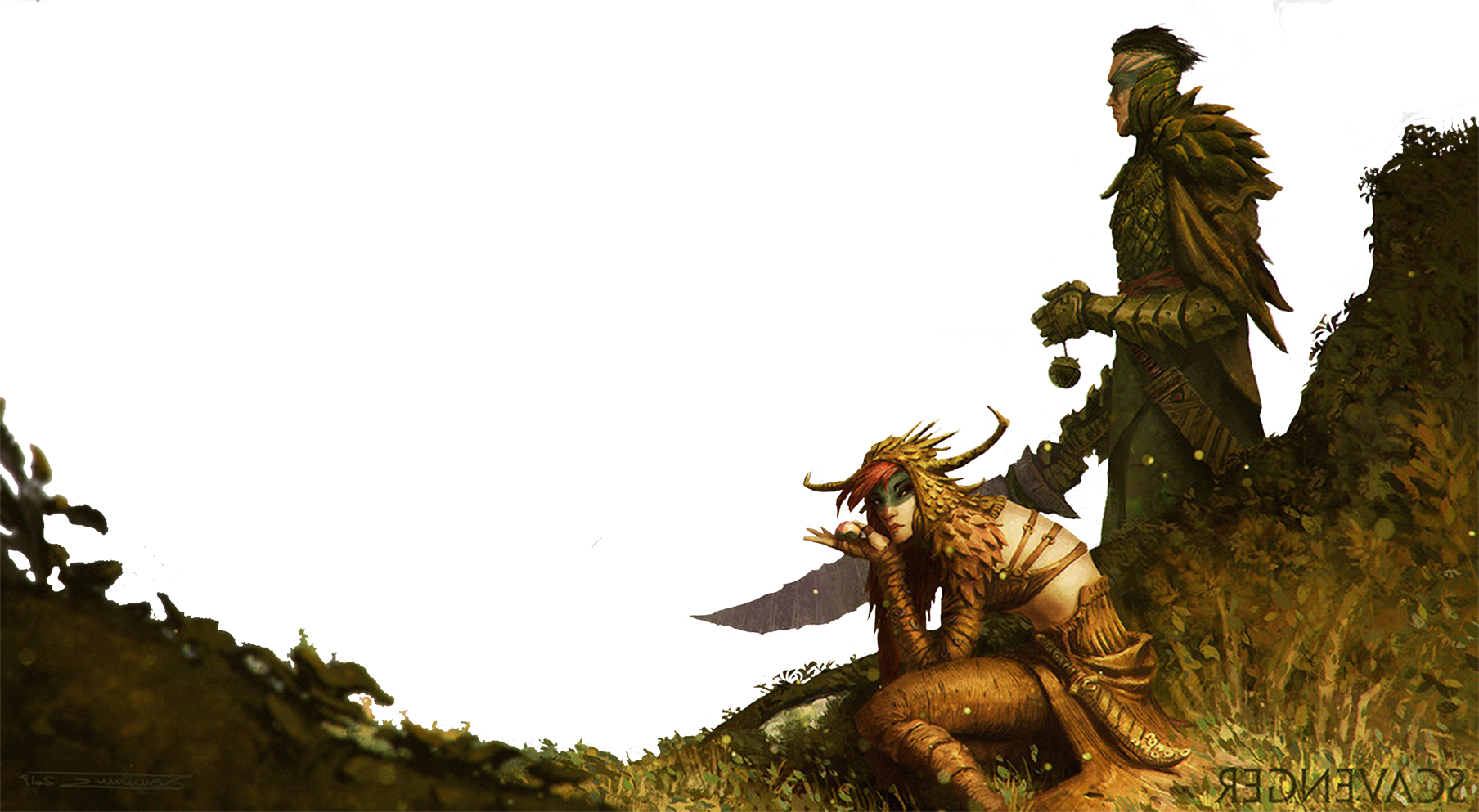
New Fighting Styles
These new fighting styles can be taken instead of any within the PHB when you select a fighting style.
Battle Awareness
While there are two or more hostile creatures within 5 feet of you, you gain a +1 bonus to your AC, and creatures within 5 feet of you can’t gain advantage on attack rolls against you as a result of having allies nearby.
Close Quarters Shooter
When making a ranged attack while you are within 5 feet of a hostile creature, you do not have disadvantage on the attack roll. Your ranged attacks ignore half cover and three-quarters cover against targets within 30 feet of you. Finally, you can make opportunity attacks with a Firearm that lacks the Two-handed property.
Dirty Fighter
When you have advantage on a melee attack, you do an additional 1d6 points of damage on a hit.
Hack and Slash
You can use a Bonus Action to enter a defensive
stance until the start of your next turn. While
in this stance, you can make opportunity
attacks without using your reaction and
you can use your reaction to make a melee weapon attack against a creature who moves within your reach.
Marauder
While not wearing medium or heavy armor, you gain a +1 bonus to your AC, your speed increases by 10 feet, and opportunity attacks are made with disadvantage against
you.
Mariner
As long as you are not wearing heavy armor or
using a shield, you have a swimming speed and a
climbing speed equal to your normal speed, and you
gain a +1 bonus to your AC.
Shield Bearer
When you take the Attack action while wielding a
shield, you can use a bonus action to attack with your
shield. The shield is a melee weapon that you are
proficient with, and does 1d6 points of bludgeoning
damage. In addition, the amount of piercing, slashing, or bludgeoning damage you take while wielding a shield is reduced by an amount equal to the shields AC bonus.
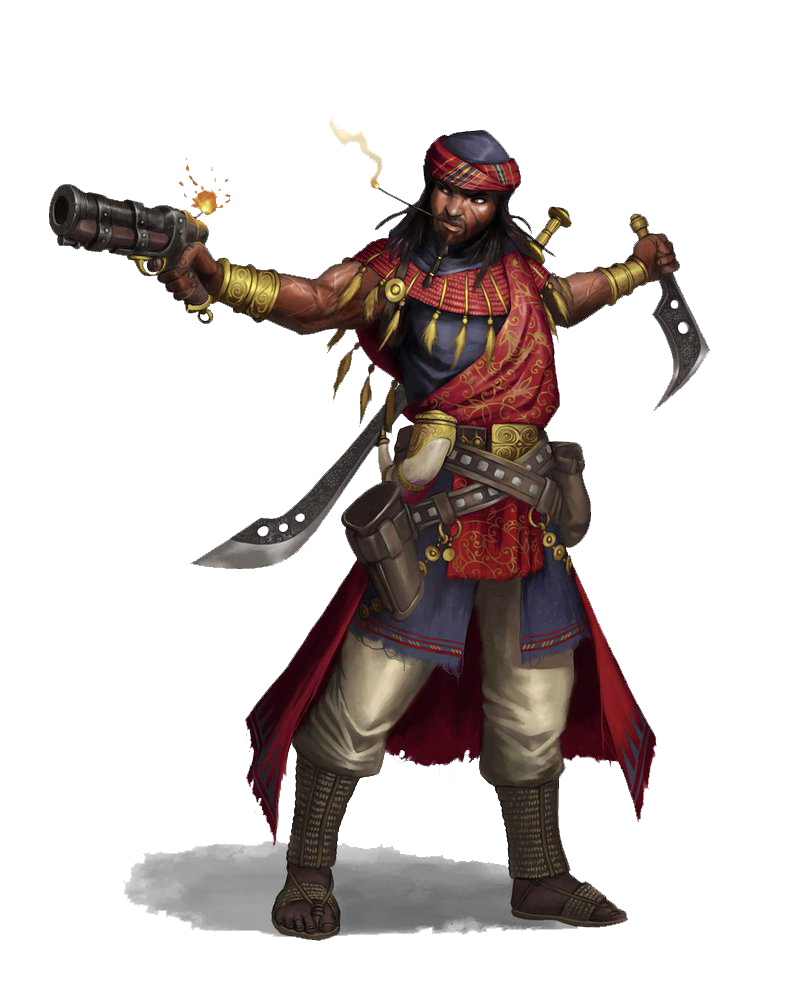
Chapter III
Traversing the Seas
In this chapter, you will find the rules for traversing the seas of Valindris and the statistics for different ships and naval equipment.
Types of Ships
Note that the individual ships described here actually represent general information that applies to many similar types of vessels. For example, the description for a skiff also covers rowboats, long boats, and dinghies.
Barge
Because of its simple construction, the barge is not exceptionally seaworthy and is useful only in calm waters.
Merchants use these craft in harbors for the transportation of goods from vessel to vessel. Sailors lash the cargo onto the barge with rope, then paddle or pole the craft to their destination.
Canoe
Many canoes are simply hollowed-out logs, softened by charting or immersion in boiling water. The pliable wood allows the canoe’s builder to force the sides apart to create a broad cross-section. Other canoes consist of lightweight frames covered with hides, bark, or other pliable materials.
The canoe is an extremely versatile craft used in coastal waters and on rivers and lakes. Because of their relatively narrow beams, canoes do not possess the stability necessary for open sea voyages.
Caravel
Structurally, this vessel is the precursor to the galleon and represents one of the most advanced ships available. Of all seagoing vessels, the caravel proves the safest and most reliable for extended sea voyages.
Cargo Ship
This ship, also called a round ship, hugs the coastline as it carries its trade goods. It has two masts and triangular sails. These ships also possess a small sterncastle that provides limited shelter from the worst of weather conditions.
Cog
This vessel is an improved version of the cargo ship. It has a single mast supporting a square sail. It has a single deck with amply-sized fore and stern castles - useful for shelter as well as defense. This ship’s stability and cargo space make it one of the most versatile craft in Valindris.
Curragh
The curragh is a primitive vessel made from thick hides stretched over a wood-and-wicker frame. The curragh sports a single mast with square sail; however, this craft primarily travels by the use of oars. The curragh is not exceptionally seaworthy and stays well within sight of shore.
This craft is primarily used by the Skaldir to traverse between the islands of the northern seas.
Drakkar
The drakkar, or dragonship, is the largest of the Skaldir longships. Built primarily for war, it possesses a single mast, but the drakkar’s main power comes from its oars, each manned by a single crewmember. Due to its great length the drakkar is not particularly seaworthy.
Fishing Boat
Used mostly by the rustic folk of coastal villages and towns, fishing boats represent the most common type of ship encountered near civilized areas. Fishing boats come in a variety of forms, though all share a basic design. Most fishing boats possess a single, small mast for sailing.
These craft are fairly stable. A skilled sailor could take a fishing boat out for a short sea voyage, as the ship can hold up to 1,000 pounds of cargo and features a small coveted area in the bow for shelter. However, the dangers involved in such a pursuit usually keep the fishing boat close to shore.
Galleon
The galleon is the mightiest of transport ships found in Valindris. These large vessels generally carry three or more masts with a lateen fore-and-aft rig on the rear masts. Most of the Markhesian Guilds use these ships to transport supplies as galleons are also fairly well armed and have ample room for a large crew and numerous passengers.
Galley
Most of the galley's power stems from 140 oars. However, three masts supplement the great galley's speed and maneuverability, making the ship useful in trade and deadly in war. It also possess a powerful ram. This ship makes up the majority of Hoten's navy.
Longship
This is the standard craft used by the Skaldir. Each side of the vessel contains 20 to 25 oars; a single mast with a square sail stands in the center of the vessel. Although these ships can carry cargo, their relatively small capacity limits their effectiveness in trade. Because of their sail, oars, and overall design, longships prove fairly seaworthy.
Outrigger
These vessels are nothing more than canoes with streamlined floats joined parallel to the hull of the ship for added stability. Some versions of the outrigger possess one float, while others have two. Single-float outriggers lack the seaworthiness of their double-float cousins, but are somewhat faster, as the dual float design adds drag to the craft.
Outriggers average a length of 30 feet and a beam of 16 feet - although larger outriggers, consisting of several canoes connected by a rectangular platform, can be as much as 80 feet wide. Average-sized outriggers can hold a crew of about 6 people, plus 500 pounds of additional cargo. The largest of these craft can easily hold up to 20 crew and almost 5 tons of cargo. All outriggers possess a single mast. In the event of poor weather, however, sailors can use paddles to move the craft.
Outriggers are fairly seaworthy, yet simple to build. They are commonly used by the Lizardfolk to traverse the southern islands, as well as many other small towns and villages throughout the world.
Raft
A raft is a simple craft constructed from logs lashed together to make a floating platform. This vessel often serves as a river ferry, as it can easily travel with the current. Rafts can range anywhere from 5 feet to 40 feet. These vessels can hold 3 tons for every 10 feet in length. Thus, a 40 foot raft could carry 12 tons of cargo.
Skiff
These fairly small craft function primarily as workboats on larger vessels and in harbors. Being narrow, skiffs prove slightly unstable. Although capable of short sea voyages, the absence of crew quarters on a skiff, as well as its tendency to capsize or swamp in rough weather, makes any such voyage dangerous.
Sohar
The sohar is a common Markhesian merchant ship. The ship possesses three masts, a small forecastle, and crew quarters for 20 people. The sohar’s stability, maneuverability, and speed make it an ideal vessel for trade or war.
Trireme
The trireme has three banks of oars. The ship possesses a single mast (which can be lowered in time of battle), a detachable ram, and two stern rudders. Although extremely seaworthy, the trireme possesses little space for supplies. Thus, the ship must remain near shore to restock.
Ships
| Ship | Size(L/W) | Crew | Pass. | Cargo | Mounts(L/H) | Speed(mph) | AC | DT | HP | Cost | Building Time |
|---|---|---|---|---|---|---|---|---|---|---|---|
| Barge | (20/10) | 3 | 2 | 8 tons | (2/1) | .5 | 15 | 75 | 15 | 500 gp | 1 week |
| Canoe | (10/5) | 1 | 2 | 500 lbs | (-/-) | 1 | 11 | - | 40 | 30 gp | 3 days |
| Caravel | (70/20) | 20 | 20 | 100 tons | (2/8) | 2 | 15 | 15 | 300 | 10,000 gp | 5 months |
| Cargo Ship | (70/25) | 10 | 10 | 100 tons | (1/4) | 1 | 15 | 15 | 200 | 10,500 gp | 3 months |
| Cog | (90/20) | 8 | 5 | 150 tons | (2/6) | 2 | 15 | 15 | 300 | 20,000 gp | 4 months |
| Curragh | (20/5) | 6 | - | 5 tons | (-/-) | 1.5 | 11 | - | 100 | 60 gp | 1 week |
| Drakkar | (100/15) | 60 | 160 | - | (2/-) | 3 | 11 | 200 | 10 | 20,000 gp | 2 months |
| Fishing Boat | (30/6) | 1 | 5 | 1,000 lbs | (1/-) | 1 | 15 | 15 | 75 | 350 gp | 3 weeks |
| Galleon | (100/25) | 100 | 30 | 50 tons | (4/10) | 7 | 15 | 20 | 500 | 40,000 gp | 6 months |
| Galley | (130/20) | 80 | - | 150 tons | (6/-) | 4 | 15 | 20 | 500 | 30,000 gp | 4 months |
| Longship | (75/15) | 40 | 150 | 10 tons | (2/6) | 3 | 15 | 15 | 300 | 10,000 gp | 1 month |
| Outrigger | (30/16) | 3 | - | 500 lbs | (1/-) | 1 | 11 | - | 150 | 75 gp | 1 week |
| Raft | (10/10) | 1 | - | 3 tons | (-/-) | .5 | 11 | - | 50 | 10 gp | 3 days |
| Skiff | (16/5) | 1 | 3 | 500 lbs | (1/-) | 1.5 | 11 | 50 | 10 | 150 gp | 1 week |
| Sohar | (90/25) | 8 | 4 | 1,500 lbs | (1/2) | 3 | 15 | 15 | 300 | 12,500 gp | 3 months |
| Trireme | (135/20) | 120 | 10 | - | (4/2) | 4 | 15 | 20 | 600 | 20,000 gp | 4 months |
Ship Statistics
The table above details the characteristics of a variety of ships that might be found in the game. The statistics given represent the most common versions of these vessels. Individual variation can occur at the DM's discretion. Thus, player characters can encounter a longship with less cargo capacity but greater speed than that listed on the table.
Resistances
Ships are naturally resistant to Bludgeoning, Piercing, and Slashing damage that lacks the Siege property. They are also immune to poison and psychic damage.
Size (Length/Width)
This represents the ship's Length and Width in feet.
Crew
This is the number of required for a sufficient crew. A sufficient crew is needed to efficiently operate the vessel. For ships that use oars, the number of crewmen rarely exceeds this number. But for sailing ships, the number of crew aboard the ship may be much larger. Each crewman can only work 8 hours a day without risking exhaustion. So with only a sufficient crew the ship will have to beach or anchor for all but 8 hours a day (as rowed ships normally do). To travel 24 hours a day requires three shifts of 8 hours each, so you will need a fully crewed ship with 3 times this many crewmen to operate 24 hours a day.
For extended voyages, or dangerous ones, there is a real danger of losing crewman so most ships carry more crewmen than needed for a full crew. The maximum number of crew members a ship can support per shift, as well as the total number of crew members that can work on a vessel without getting in each other's way, is double the number for a sufficient crew.
The absolute minimum number of crewmen required to operate this vessel is half the sufficient crew number (rounded up). If a ship has less than this number of crew on board, it is effectively crippled.
Operating with less than a sufficient crew, but at least the minimum (hereafter called a skeleton crew) needed to run the ship presents several obstacles. First, ships manned by skeleton crews cannot attempt to increase their movement rate as can other ships with full crew complements. Second, ships with skeleton crews suffer a disadvantage on all combat actions.
If a ship’s crew ever falls below the minimum required, the ship's speed falls to 1 mph - the vessel mostly drifts with the wind and current. In combat, the ship automatically fails all maneuver checks. The ship cannot attempt to ram, board, or evade.
These numbers do not include officers or infantry.
Passengers
This indicates the total number of extra personnel (people not involved in actually operating the ship) a ship can carry. If a ship carries infantry, they occupy passenger space.
Cargo
This represents the total amount of carrying capacity for each ship. Ships usually possess some sort of cargo hold to protect their goods - though many vessels store cargo inside stern and fore castles, or simply lashed to their decks.
Mounts (Light/Heavy)
The number of weapons the ship can mount. The number before the slash is the number of light mounts, the number after the slash is the number of heavy mounts. A light mount is suitable for a swivel gun, light ballista, or light cannon. A heavy mount is suitable for a full sized cannon, mortar station, or heavy siege weapon.
Speed (MpH)
This is the vessel’s speed in miles per hour (mph). For combat, you can convert these speeds to feet per round by multiplying them by 10.
AC
The ship's Armor Class.
Damage Threshold (DT)
This represents the sturdiness and durability of the ship. When a ship with a DT rating is dealt damage by a source without Siege, it reduces that damage by an amount equal to it's DT rating.
Hit Points (HP)
The number of hit points for the ship’s hull, also called hull points. When a ship’s hull points reach 0 it is immobile and may sink.
Cost
The amount of gold it takes to construct a ship. This represents the cost of materials and labor in most cases.
Building Time
This is the total amount of time required to build a ship from start to finish, assuming that the necessary materials, labor, and facilities are available.
Ship Upgrades
You may find that your ships needs further modifications. The augmentations listed below are not possible for some ships. As a general guide they are not available to smaller ships (less than 50 feet in length). It will take at least 1 week to add any of these, perhaps longer if the materials are not readily available.
Additional Crew/Passenger Space
Cost: 20% of base ship cost.
This translates into more space for a ship’s sailors to sleep and eat. The ship may support 10% more passengers, but its cargo capacity is decreased by 10%.
Armor Plating
Cost: 30% of base ship cost.
By attaching metal plates to the ship, the hull’s hit points are increased by +15. This modification reduces a ship’s cargo capacity by 15%. The armor plating imposes a –1 penalty on all sailing checks, and slows the ship by 1 mph (to a minimum of 1 mph).
Broad Rudder
Cost: 500 gp
A wide rudder makes a ship more nimble, granting a +1 bonus on all sailing checks.
Concealed Weapon Port
Cost: 300 gp per port (plus the cost of the weapon).
The ship’s belowdecks area undergoes major reconstruction in order to provide a light mount for weapon. A concealed weapon port can only be recognized on a successful DC 15 Wisdom (Perception) check. Each concealed port reduces a ship’s cargo capacity by 5 tons, in addition to the space required by the weapon itself.
Davit
Cost: 500/1,500 gp
A davit is a special hoist and cradle designed to carry small boats on the deck of a larger ship. Most ships carry a skiff or two stowed on deck, but a davit can accommodate a fairly large boat, and makes launching and recovering the vessel much easier. A large davit can hold a boat up to 50 feet long. It costs 500 gp and requires a light mount; a huge davit can hold a boat up to 90 feet long. It costs 1,500 gp and requires a heavy mount. A davit cannot carry a ship larger then the one it is mounted on.
Launching a boat with a davit requires only a single action from one crew member; recovering a boat requires 1 minute and two crew members for a Large boat or eight crew members for a Huge boat. The cost of the davit does not include the craft carried in the davit.
Diving Bell
Cost: 2,700 gp
The diving bell is a sturdy weighted barrel or sphere of wood and iron, fitted with several thick glass portholes. It can hold up to two Medium creatures. The bell descends on a stout cable from the ship above, and can’t move horizontally. It can only ascend or descend at a rate of 10 feet per round. The bell can descend to a maximum depth of 100 feet.
Bells can be left open on the bottom, allowing a swimmer to easily enter or exit the bell. The air inside the bell will prevent the water from completely filling the bell, although the deeper you descend, the less headroom you have. An open bell can descend to a maximum depth of 100 feet, at which point everyone inside will be neck-deep in water.
The diving bell apparatus includes a davit or hoist on the ship’s deck for raising or lowering the bell, and a crude handpowered air pump and waterproofed hose of canvas or leather to provide fresh air to the bell. It takes 2 people to work the pumps, and a crew of 4 to operate the winch to raise or lower the bell.
The bell itself weighs 1,000 pounds. The hoist on deck takes up a 10’ space and uses a heavy mount.
Extended Keel
Cost: 10% of the base ship cost.
The ship’s keel is longer than usual for a vessel of its type. The ship’s measurements from bow to stern are 10% longer than normal, though cargo capacity is not appreciably affected. The ship is more stable, and grants a +1 bonus on all sailing checks.
This improvement must be installed at the time of the ship’s construction and cannot be added later.
Figurehead
Cost: Varied (at least 150 gp)
Some ships sport a fanciful carving on its bow. These often resemble some mythical sea creature or beautiful maiden. This grants the crew and passengers of the ship a +2 bonus on saving throws to resist fear and charm effects while on board the ship.
Firing Castle
Cost: 1,000 gp
A bunker attached to the deck of a vehicle, the firing castle provides protection for defenders and serves as a platform for siege engines. Four medium-size defenders benefit from three-quarters cover (+5 AC and Dexterity saves) in the firing castle itself, which is 10’ by 10’, and another four get half cover (+2 AC and Dexterity saves) behind the crenellations on its roof. The firing castle’s walls are 1’ thick masonry (HP 90, DR 10). A firing castle can be installed on a heavy mount, and a heavy mount exists atop it.
Grappling Ramp
Cost: 500 gp
This structure is a long ramp and frame that resembles a small drawbridge. When an enemy ship is near, the grappling ramp is dropped, so that it forms a bridge to the other vessel. The top end of the grappling ramp is usually fitted with iron spikes, cleats, or grapnels so that its drop drives the ramp into the enemy vessel’s deck, holding it fast. A grappling ramp gives you a +4 bonus on Wisdom (Vehicle) checks to initiate a grapple with another ship or to maintain a grapple from a foe who wants to escape, but no bonus on resisting another ship’s attempt to grapple your own vessel. It also creates a 5’ wide bridge to the other vessel’s deck.
Improved Controls
Cost: 950 gp
With a finely tuned wheel that allows delicate adjustments to the rudder, it’s possible to get more performance out of a vehicle by improving its control system. Improved controls provide a +2 bonus to a sailing checks. This cannot be put onto a ship with a Broad Rudder.
Increased Cargo Capacity
Cost: 15% of the base ship cost.
An efficient remodeling of the ship’s layout means more room for the ship’s stores. The ship’s cargo capacity is increased by 10%.
Narrow Hull
Cost: 15% of the base ships cost.
The ship has been intentionally designed with a more slender hull, enabling it to slip through smaller spaces. The ship’s beam (width) is decreased by 20%, and cargo capacity is reduced by 10%. The ship gains a +2 bonus on all sailing checks.
This improvement must be installed at the time of the ship’s construction and cannot be added later.
Ramming Plow
Cost: 1,000 gp
The ship bears a standard ram, usually sheathed in bronze or iron, mounted on its bow. A ship equipped with a Ramming Prow does an additional 1d6 damage to the enemy ship for every 1 mph of ship speed on a successful ram maneuver.
Rapid-Deploy Sails
Cost: 10% of ships base cost.
The ship’s rigging undergoes a wholesale change as improvements in engineering enable the sails to be raised and lowered much faster than normal. Any sail adjustments can be made in half the normal time, granting a +1 bonus on all sailing checks.
Silk Sails
Cost: 15% of ships base cost.
Few ship improvements are as beautiful as the addition of silk sails. These sails can be designed in whatever color the player desires; they are often embroidered with striking images of the sea. Silk sails give the ship superior rates of movement, as they capture and displace the wind more efficiently.
A ship with silk sails gains a +1 bonus on opposed sailing checks. The ship’s speed is increased by 1 mph.
Smuggling Compartments
Cost: 500 gp per 5 ft square compartment.
The ship’s bulkheads are modified so that gaps between them can serve as hidden cargo storage areas. This does not change a ship’s cargo capacity. A DC 20 Wisdom (Perception) check is required to locate smuggling compartments in a search of the ship.
A ship can be fitted with no more than four smuggling compartments.
Sturdy Hull
Cost: 10% of the ships base cost.
The ship’s body has had additional supports and layers of wood added to it, making it thicker and more resilient. The hull’s damage threshold is increased by 2, but the ship’s cargo capacity is reduced by 10%.
Wooden Plating
Cost: 20% of ships base cost.
For protection during naval combat, this ship has received additional wooden planks nailed to its hull. The hull’s hit points are increased by 5% and its damage threshold is increased by 2. However, this reduces cargo capacity by 10% as extra room must be made inside for beams to support the reinforcements. The speed is reduced by 1 mph (to a minimum of 1 mph).


Ship Weapons
The following weapons are available for ships.
Swivel Gun
Crew: 1
These small cannons are mounted to swivel posts above deck. They are excellent at punching holes through small ships and cutting down personnel. They are slow to reload, but can be manned by 1 person easily.
Cannon
Crew: 3
A full sized cannon can wreak havoc on a ship, tearing through hulls and masts alike. They are typically mounted below deck on most ships that can accommodate them.
Mortar Station
Crew: 3
These hefty upward facing cannons are able to rain down destruction from afar. They require one person to serve as a range calculator that inputs target coordinates into dials that control the weapons tilt and facing.
These weapons cannot fire on targets within 200 feet.
Light Ballista
Crew: 1
A very common type of ballista, also called an arbalest or scorpion. It can be operated by a single person and is designed for dealing with personnel on other ships, making it less effective against enemy ships themselves.
Medium Ballista
Crew: 2
This larger ballista has a longer range and fires a much heavier bolt. This allows it to deal with enemy ships much easier.
Heavy Ballista
Crew: 3
These huge siege engines are commonly used as castle defenses as well as on large warships. Though a bit dated since the advent of black power and the cannon. Nonetheless, these still prove effective weapons against oncoming ships.
Flame Spewer
Crew: 4
This ghastly weapon was invented by a team of goblin engineers not too long ago. It resembles a normal cannon but with a large tank affixed to its backside and a large cocking lever on its right side. When fired, this weapon spews molten flame out of its barrel, igniting anything in its trajectory. It is a highly efficient weapon against both ships and personnel.
Mangonel
Crew: 3
Another fairly dated weapon. These catapults are generally affixed to the deck of a ship on a swivel base. One added benefit of this weapon though is that it is easily able to fire specialized ammunition without fear of the ammo getting broken inside of a cannon barrel.
Arcane Howler
Crew: 2
A recent invention from the arcane society within Markhanis. This cannon is slightly smaller then a full sized cannon and is usually made from an ornate marble looking material. It is able to discharge bolts of pure arcane energy. These bolts hit with tremendous impact and then manage to do even further damage to anything close to the impact site. And as long as one of the crew is proficient with Arcana, it is a fairly easy weapon to maintain.
Class Name
| Weapon | Cost | Damage | RoF | Weight | Range | Mount | Properties |
|---|---|---|---|---|---|---|---|
| Swivel Gun | 1,500gp | 3d8 bludgeoning | 1/2 | 85 lbs | (200/1,200) | Light | Mounted, Reload 1, Misfire 1, Siege |
| Cannon | 3,500 gp | 8d10 bludgeoning | 1/3 | 2,500 lbs | (600/2,400) | Heavy | Mounted, Reload 1, Misfire 1, Siege |
| Mortar Station | 3,000 gp | 10d6 fire(40 ft) | 1/4 | 2,000 lbs | (200-3,500) | Heavy | Mounted, Reload 1, Misfire 1, Trajectory, Explosive, Siege |
| Light Ballista | 400 gp | 2d10 piercing | 1/1 | 45 lbs | (60/240) | Light | Mounted, Reload 1 |
| Medium Ballista | 650 gp | 3d10 piercing | 1/2 | 90 lbs | (80/360) | Light | Mounted, Reload 1, Siege |
| Heavy Ballista | 800 gp | 5d10 piercing | 1/3 | 300 lbs | (120/480) | Heavy | Mounted, Reload 1, Siege |
| Flame Spewer | 6,500 gp | 8d10 fire | 1/3 | 1,250 lbs | 60 ft cone | Heavy | Mounted, Siege |
| Mangonel | 700 gp | 4d10 bludgeoning | 1/4 | 350 lbs | (150/600) | Heavy | Mounted, Reload 1, Trajectory, Siege |
| Arcane Howler | 10,000 gp | 10d10 force | 1/3 | 1,000 lbs | (400/3,000) | Heavy | Mounted, Reload 1, Explosive, Siege |
Weapon Properties
The table above shows weapon properties that apply to the siege weapons you are able to mount on a ship. The properties that appear here and in the firearms table function the same. These are the new mechanics introduced with Siege Weapons.
Rate of Fire (RoF)
This refers to how often a weapon can fire. A weapon with a RoF of 1/3 can fire once every three rounds, or 1/3 rounds. The rounds between attacks are used to reload and aim the weapon.
Crews
The number of creatures that it takes to operate a weapon. If the weapon is being controlled by less then its normal crew, the number of rounds it takes to load and aim is doubled.
Special Ammunition
Certain siege weapons can fire special ammunition. The table below details the cost of some ammunition per piece, and the description of the ammunitions below detail which weapons can fire them.
In the cases of misfiring special ammunition, it will usually detonate within the weapon firing it and center its effect on that weapon.
| Ammunition | Cost |
|---|---|
| Alchemical Fire | 200 gp |
| Blessed Canisters | 500 gp |
| Chain Shot | 50 gp |
| Charged Bolt | 200 gp |
| Depth Charge | 400 gp |
| Liquid Ice | 400 gp |
| Plague Bundle | 80 gp |
| Smoke Shot | 250 gp |
Alchemical Fire
Fired By: Cannon, Medium Ballista, Mangonel
A ceramic or metal container filled with Alchemical Fire.
When it hits its target, it deals 4d6 fire damage. Creatures within 5 feet of the target must make a DC 16 Dexterity saving throw, taking 3d6 fire damage on a failed save or half as much on a success. Objects hit by this, as well as creatures who fail their saving throw are ignited and continue to burn.
A burning object or creature takes 2d6 fire damage at the start of its turn. An action must be spent to douse the flames.
Blessed Canister
Fired By: Cannon, Medium or Heavy Ballista, Mangonel
A metal canister filled with holy energy. These canisters are blessed over a long ritual and are intended to combat large
undead and fiendish threats. On a hit, the canister deals 4d8 radiant damage to the target. Creatures within 20 feet of the
target must make a DC 20 Constitution saving throw, taking the same damage on a failed save, or half as much on a success.
Undead and Fiends have disadvantage on their saving throw to avoid this damage.
Chain Shot
Fired By: Cannon, Mangonel
Two small metal balls affixed to one another with an iron chain. Chain shot is highly effective at tearing through sails and rigging. On a hit, it deals 6d6 bludgeoning damage if fired from a cannon, or 4d6 bludgeoning damage if fired from a mangonel. These critically hit against a ships sails and rigging on a roll of 18-20.
Charged Bolt
Fired By: Light, Medium, or Heavy Ballista
These bolts are inscribed with evocation runes that allow it to store arcane lightning. These bolts deal lightning damage, and increase the normal damage of the weapon firing them by 1 die.
For example, a Medium Ballista firing this would deal 4d10 lightning damage instead of 3d10 piercing.
Once the bolt hits, lightning continues to arc in a 10 foot radius around the bolt. Creatures who start their turn in this area, or enter it for the first time on a turn must make a DC 15 Constitution saving throw, taking 3d6 lightning damage on a failed save, or half as much on a success.
Depth Charge
Fired By: Mangonel, Dropped
These metal containers are filled with a highly volatile mixture of explosive material. They are designed to be anchored down just below the waters surface and detonate whenever a ship passes through their space. The resulting blast deals 8d6 bludgeoning damage to the ship and any creatures within 20 feet of the blast.
Liquid Ice
Fired By: Cannon, Mangonel
A charged metal container filled with Alchemical Ice. When this hit, it deals 4d6 cold damage to the target. Ice begins to spread within a 20 foot radius of the impact. Creatures within this area must make a DC 20 Constitution saving throw, taking 3d6 cold damage on a failed save, or half as much on a success.
Until the end of your next turn, the ground within 20 feet of the impact also becomes difficult terrain. Creatures must move across it at half speed. If they move faster, they must make a DC 20 Dexterity saving throw or fall prone.
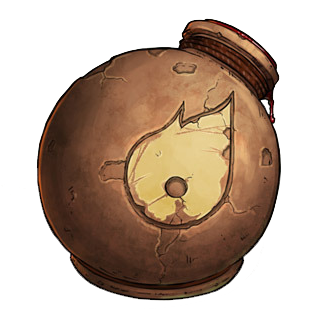
Plague Bundle
Fired By: Cannon, Mangonel
A ceramic or metal ball containing a noxious mass of diseased carrion. On a hit, this leaves a cloud of rot filled gas in a 20 foot radius from the impact. Creatures within this area are exposed to Sewer Plague (Dungeon Masters Guide p. 257). Strong winds disperse this cloud by the end of your next turn, otherwise it remains until the bile is cleared with an action.
Smoke Shot
Fired By: Swivel Gun, Cannon, Mangonel
A ceramic or metal ball containing two alchemical mixtures. On a hit, the two substances mix and produce a large yellow cloud of smoke. This effect functions as a 1st level fog cloud spell.
Roles Aboard a Ship
While on a ship, there are roles that need to be filled. This can be done by NPCs depending on how many players are on board. Some of these roles are vital to the ship's ability to move and act in combat though. Below are a list of the roles that can be filled on a ship.
Captain/First Mate
One of the most important roles on a ship is its captain.
The captain directs the crew and makes sure their
ship is running in tip top shape. When the Captain or
First Mate of a ship acts, they can perform a number of different actions to help the crew and the ship.
Rally. As an action, you instill bravery in your crew, or perhaps scare them into acting. You make a Charisma (Persuasion) or (Intimidation) check. The DC for this check is naturally 15, but can gain modifiers based on the crew's morale (covered later in this section). If the check succeeds, the crew gain advantage on one role during this combat.
Weak Spot. You try and find a weak point in the enemy's ship and call it out to your crew. As an action, you make a Wisdom (Perception) check against a natural DC 15 (modifiers may be applied). If you succeed, you can direct your crew to attack a weak point that you have spotted. This grants advantage on the next attack your ship makes, and increases the dice rolled for damage on a hit by 1/2. Once you use this action against a ship, you cannot use it again against the same ship.
Order Broadside. The Captain or First Mate orders a broadside. All of the weapons on one side of the ship fire at once using the Cannoneer's reactions. These attacks are made at advantage. This can only be performed if all the weapons along one side of the ship are loaded and ready to fire. This can only be used once per combat.
Pilot
The pilot steers the ship along its coarse. A pilot must be proficient with either Navigator's tools or Sea Vehicles. Pilots can use their actions to make sure the ship isn't left adrift or going off coarse.
Sailing checks are made using the pilots Dexterity or Wisdom and Proficiency bonus. The DC of sailing checks will be determined by the condition of the seas and weather, as well as the current situation the ship is in during combat.
Connoneer
Cannoneers operate the siege weapons aboard a ship. Cannoneers use their actions to fire, reload, and aim the weapons they are in part of the crew of. A siege weapon's attack bonus is +6 unless the cannoneer is proficient with firearms or siege weapons. If an NPC is crew is manning a weapon, the attack bonus is only +3.
Surgeons
Surgeons act as the medics aboard a ship. It is their job to make sure the crew and passengers are in good shape and able to perform their duties. Surgeons are often spellcasters with access to healing magic. They spend their actions healing the crew, making light repairs to the ship, and putting out fires and other hazards aboard the ship.
As an action, the surgeon can
restore one crew member to
good health with a DC 15
Wisdom (Medicine) check.
Healing magic can restore
more crew members to good
health.
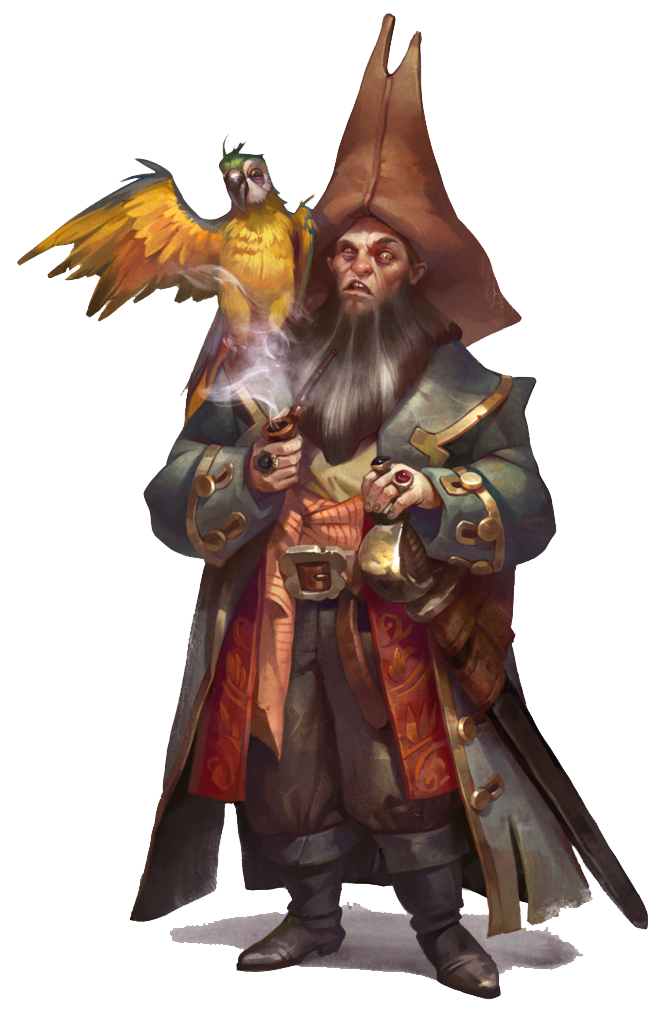
Nautical Travel
Ships generally move by means of oars or sails. At its simplest, rowing requires much more physical energy than sailing, and in the case of vessels with multiple rowers, a skilled Oarsmaster is needed to coordinate the rowers. Sailing, on the other hand, requires a keen understanding of winds and oceanic conditions, as well as a practiced hand in performing nautical maneuvers designed to maximize the effects of the winds.
Rowing
As mentioned earlier, rowing a ship with a multitude of oarlocks, such as a trireme, requires a great deal of skill and coordination from all involved - especially the oarsmaster. An Oarsmaster has to make checks to ensure the rowers under their command are performing up to task.
This check is rolled as a Charisma (Persuasion) or Charisma (Intimidation) check. The DC is 10 if the rowers are in good spirits, but the DC will increase as the rowers begin to tire or feel ill will towards the Oarsmaster or ship.
Daily Movement
A boat traveling by oar can travel for 8 hours a day, or they can row longer at the risk of exhaustion. For every hour beyond 8 that the ship travels, the rowers are required to make a DC 10 Constitution saving throw to stave off exhaustion. This DC increases by 2 each time the saving throw is required beyond the first.
The distance a ship can travel in a normal day can be calculated by multiplying the ship's speed by 8.
Moving Under Oar and Sails
Some ships utilize both sails and oars. These ships count as sailing ships. Wind strength modifies their base speed while the rowers maintain their base speed.
Sailing
Sailing vessels use the natural force generated by winds to move, so they are somewhat at the mercy of the prevailing wind. A strong wind can greatly speed a long journey, or make even the shortest jaunt a slow and dangerous affair, depending on the wind’s direction relative to the course desired.
| Wind | Movement Rate | Speed Mod |
|---|---|---|
| Calm | Can't sail | - |
| Light | Into | -1 mph |
| - | With | +1 mph |
| - | Across | +0 mph |
| Moderate | Into | -2 mph |
| - | With | +2 mph |
| - | Across | +1 mph |
| Strong | Into | No movement |
| - | With | +3 mph |
| - | Across | +2 mph |
| Gale | Into | 1 mph backwards |
| - | With | +4 mph |
| - | Across | +3 mph |
| Storm | - | Driven at 1d4 mph in the direction the wind is blowing |
Daily Movement
Fully crewed sailing ships have a far greater daily movement rate than rowed vessels. A sailing ship that has between a half crew and a full crew or more can travel for 12 hours a day. A skeleton crew can only travel for 8 hours, and at half speed.
Anchored at Night
If a sailing ship anchors from dusk till dawn rather than sailing through the night, multiply its base speed by 16 hours to determine its maximum daily movement rate. Note that sailing through the night requires a highly skilled navigator. Without proper navigation through the night, a ship should stay within sight of land or risk becoming lost at sea.
Anchoring at night often proves a smart idea too. As dangers that are easily visible during the day, such as sandbars, shoals, and reefs, become nearly invisible at night.


Campaign Guide:
Valindris
Long ago, the world of Valindris was flooded when the barrier between the Material Plane and the Elemental Plane of Water was shattered during a cataclysmic war. Civilization now exists atop of islands that litter Valindris' vast oceans.
High adventure and mystery await any adventurers that find themselves courageous enough to brave the open waters. Ancient ruins litter the the ocean floor, forgotten temples line what was once great mountain peaks, and otherworldly creatures hoard ancient relics that have not been seen by mortals in centuries.
Cover Art: Mathieu Lauffray


